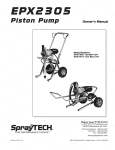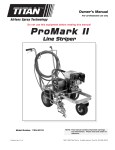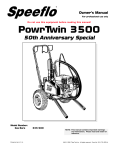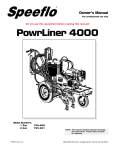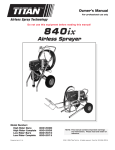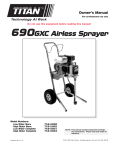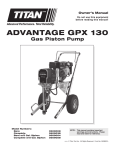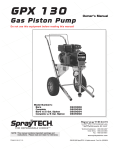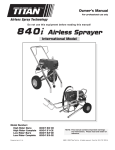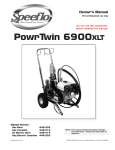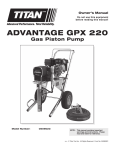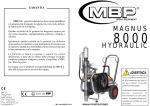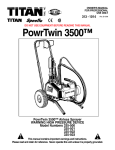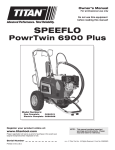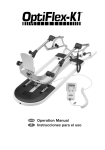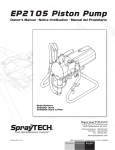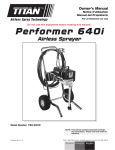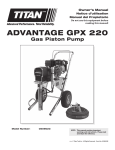Download GPX1250 - Titan Tool USA
Transcript
GPX 1250
Owner’s Manual
G a s Pi s to n Pu m p
Model Number 0509005
SprayTECH
1770 Fernbrook Lane
Minneapolis, MN 55447
Technical Assistance: 1-800-292-4637
Order Entry: 1-800-443-4500
Fax: 1-800-525-9501
w w w. s p ray t e chinc .c om
Printed in the U. S. A.
1202 © 2002 SprayTECH. All rights reserved. Form No. 0509812A
Table of Contents
PREVENTION:
• NEVER aim the gun at any part of the body.
• NEVER allow any part of the body to touch the fluid stream.
DO NOT allow body to touch a leak in the fluid hose.
• NEVER put your hand in front of the gun. Gloves will not
provide protection against an injection injury.
• ALWAYS lock the gun trigger, shut the pump off, and release
all pressure before servicing, cleaning the tip or guard,
changing tip, or leaving unattended. Pressure will not be
released by turning off the motor. The PRIME/SPRAY knob
must be turned to PRIME to relieve the pressure. Refer to
the PRESSURE RELIEF PRESSURE described in the pump
manual.
• ALWAYS keep the tip guard in place while spraying. The
tip guard provides some protection but is mainly a warning
device.
• ALWAYS remove the spray tip before flushing or cleaning
the system.
• The paint hose can develop leaks from wear, kinking and
abuse. A leak can inject material into the skin. Inspect
the hose before each use.
• NEVER use a spray gun without a trigger lock and trigger
guard in place and in good working order.
• All accessories must be rated at or above 3300 PSI / 228
BAR. This includes spray tips, guns, extensions, and
hose.
Safety Precautions .................................................................2
Français ..............................................................................18
Español ...............................................................................20
General Description ...............................................................4
Operation ................................................................................4
Setup ....................................................................................4
Preparing to Paint .................................................................4
Painting .................................................................................5
Pressure Relief Procedure ...................................................6
Spraying ..................................................................................6
Spraying Technique ..............................................................6
Practice .................................................................................6
Cleanup ...................................................................................7
Maintenance............................................................................7
General Repair and Service Notes.......................................7
Maintaining the Engine .........................................................8
Replacing the Filter...............................................................8
Replacing the PRIME/SPRAY Valve.....................................8
Replacing the Potentiometer ................................................9
Replacing the Pump ON/OFF Switch ...................................9
Replacing the Transducer...................................................10
Replacing the Electronic Pressure Control (EPC) Board ...10
Replacing the Slider Assembly and Slider Housing............11
Replacing the Gears ...........................................................12
Servicing the Clutch Assembly ...........................................12
Servicing the Fluid Section .................................................14
Troubleshooting ...................................................................16
Parts Listings........................................................................22
Main Assembly....................................................................22
Drive Assembly ...................................................................23
Fluid Section Assembly ......................................................24
Cart Assembly.....................................................................25
Filter Assembly ...................................................................25
PRIME/SPRAY Assembly ...................................................26
Electrical Schematic ...........................................................26
Labels .................................................................................26
Accessories ........................................................................27
Limited Warranty ..................................................................28
NOTE TO PHYSICIAN:
Injection into the skin is a traumatic injury. It is
important to treat the injury as soon as possible. DO
NOT delay treatment to research toxicity. Toxicity is a
concern with some coatings injected directly into the
blood stream. Consultation with a plastic surgeon or
reconstructive hand surgeon may be advisable.
HAZARD: EXPLOSION OR FIRE - Solvent and paint fumes
can explode or ignite. Severe injury and/or
property damage can occur.
PREVENTION:
• Provide extensive exhaust and fresh air introduction to
keep the air within the spray area free from accumulation
of flammable vapors.
• Avoid all ignition sources such as static electric sparks,
open flames, pilot lights, and hot objects. Connecting or
disconnecting power cords or working light switches can
make sparks.
• Do not smoke in spray area.
• Fire extinguisher must be present and in good working
order.
• Place paint pump in a well ventilated area. Flammable
vapors are often heavier than air. Floor area must be
extremely well ventilated. The paint pump contains arcing
parts that emit spark and can ignite vapors.
• The equipment and objects in and around the spray area
must be properly grounded to prevent static sparks.
• Use only conductive or grounded high pressure fluid hose.
Gun must be grounded through hose connections.
• Power cord must be connected to a grounded circuit
(electric models only).
• Always flush unit into a separate metal container, at low
pump pressure, with spray tip removed. Hold gun firmly
against side of container to ground container and prevent
static sparks.
• Follow the material and solvent manufacturer's warnings
and instructions.
• Use extreme caution when using materials with a
flashpoint below 70° F (21° C). Flashpoint is the
temperature that a fluid can produce enough vapors to
ignite.
• Plastic can cause static sparks. Never hang plastic to
enclose a spray area. Do not use plastic drop cloths
when spraying flammable materials.
• Use lowest possible pressure to flush equipment.
Safety Precautions
This manual contains information that must be read and
understood before using the equipment. When you come to an
area that has one of the following symbols, pay particular
attention and make certain to heed the safeguard.
WARNING
This symbol indicates a potential hazard that may cause
serious injury or loss of life. Important safety information will
follow.
CAUTION
This symbol indicates a potential hazard to you or to the
equipment. Important information that tells how to prevent
damage to the equipment or how to avoid causes of minor
injuries will follow.
NOTE: Notes give important information which should
be given special attention.
WARNING
HAZARD: Injection injury - A high pressure stream
produced by this equipment can pierce the
skin and underlying tissues, leading to serious
injury and possible amputation. See a
physician immediately.
DO NOT TREAT AN INJECTION INJURY AS A SIMPLE
CUT! Injection can lead to amputation. See a physician
immediately.
The maximum operating range of the gun is 3300 PSI /
228BAR fluid pressure.
2
© SprayTECH. All rights reserved.
Gasoline Engine Safety
GAS ENGINE (WHERE APPLICABLE)
Always place pump outside of structure in fresh air. Keep all
solvents away from the engine exhaust. Never fill fuel tank
with a running or hot engine. Hot surface can ignite spilled
fuel. Always attach ground wire from pump unit to a grounded
object, such as a metal water pipe. Refer to engine owner’s
manual for complete safety information.
HAZARD: EXPLOSION HAZARD DUE TO INCOMPATIBLE
MATERIALS - Will cause severe injury or
property damage.
PREVENTION:
• Do not use materials containing bleach or chlorine.
• Do not use halogenated hydrocarbon solvents such as
mildewcide, methylene chloride and 1,1,1 trichloroethane. They are not compatible with aluminum.
• Contact your coating supplier about the compatibility of
material with aluminum.
HAZARD: HAZARDOUS VAPORS - Paints, solvents,
insecticides, and other materials can be
harmful if inhaled or come in contact with the
body. Vapors can cause severe nausea,
fainting, or poisoning.
PREVENTION:
• Use a respirator or mask if vapors can be inhaled. Read
all instructions supplied with the mask to be sure it will
provide the necessary protection.
• Wear protective eyewear.
• Wear protective clothing as required by coating
manufacturer.
HAZARD: GENERAL - This product can cause severe
injury or property damage.
PREVENTION:
• Read all instructions and safety precautions before
operating equipment.
• Always disconnect the motor from the power supply
before working on the equipment (electric models only).
• Follow all appropriate local, state, and national codes
governing ventilation, fire prevention, and operation.
• The United States Government Safety Standards have
been adopted under the Occupational Safety and Health
Act (OSHA). These standards, particularly part 1910 of
the General Standards and part 1926 of the Construction
Standards should be consulted.
• Use only manufacturer authorized parts. User assumes
all risks and liabilities when using parts that do not meet
the minimum specifications and safety devices of the
pump manufacturer.
• Before each use, check all hoses for cuts, leaks, abrasion
or bulging of cover. Check for damage or movement of
couplings. Immediately replace the hose if any of these
conditions exist. Never repair a paint hose. Replace it
with another grounded high-pressure hose.
• All hoses, swivels, guns, and accessories must be rated at
or above 3300PSI/228 BAR.
• Do not spray outdoors on windy days.
• Wear clothing to keep paint off skin and hair.
• Always unplug cord from outlet before working on
equipment.
• Do not use this equipment to spray water or acid.
WARNING
The engine exhaust from this unit contains chemicals
known to the State of California to cause cancer, birth
defects, or other reproductive harm.
1. Gas engines are designed to give safe and dependable
service if operated according to instructions. Read and
understand the engine Owner's Manual before operating
the engine. Failure to do so could result in personal injury
or equipment damage.
2. To prevent fire hazards and to provide adequate
ventilation, keep the engine at least 1 meter (3 feet) away
from buildings and other equipment during operation. Do
not place flammable objects close to the engine.
3. Children and pets must be kept away from the area of
operation due to a possibility of burns from hot engine
components or injury from any equipment the engine may
be used to operate.
4. Know how to stop the engine quickly, and understand the
operation of all controls. Never permit anyone to operate
the engine without proper instructions.
5. Gasoline is extremely flammable and is explosive under
certain conditions.
6. Refuel in a well-ventilated area with the engine stopped.
Do not smoke or allow flames or sparks in the refueling
area or where gasoline is stored.
7. Do not overfill the fuel tank. After refueling, make sure the
tank cap is closed properly and securely.
8. Be careful not to spill fuel when refueling. Fuel vapor or
spilled fuel may ignite. If any fuel is spilled, make sure the
area is dry before starting the engine.
9. Never run the engine in an enclosed or confined area.
Exhaust contains poisonous carbon monoxide gas;
exposure may cause loss of consciousness and may lead
to death.
10. The muffler becomes very hot during operation and
remains hot for a while after stopping the engine. Be
careful not to touch the muffler while it is hot. To avoid
severe burns or fire hazards, let the engine cool before
transporting it or storing it indoors.
11. Never ship/transport unit with gasoline in the tank.
CAUTION
Do not lift by cart handle when loading or unloading.
© SprayTECH. All rights reserved.
3
General Description
Preparing a New Sprayer
If this unit is new, it is shipped with test fluid in the fluid section
to prevent corrosion during shipment and storage. This fluid
must be thoroughly cleaned out of the system with mineral
spirits before you begin spraying.
This airless sprayer is a precision power tool used for spraying
many types of materials. Read and follow this instruction
manual carefully for proper operating instructions,
maintenance, and safety information.
CAUTION
Engine
Pressure Control
Knob
Always keep the trigger lock on the spray gun in the
locked position while preparing the system.
1. Place the siphon tube into a container of mineral spirits
that has a flash point of 60ºC (140ºF) or above.
2. Place the return hose into a metal waste container.
3. Turn the pressure control knob fully counterclockwise to
its lowest pressure setting.
4. Move the PRIME/SPRAY valve to the PRIME position.
5. Move the engine ON/OFF switch to the ON position.
Throttle
6. Start the engine:
Choke Lever
Lever
a. Open the fuel valve
lever.
Engine
b. Move the throttle
ON/OFF
lever away from the
Switch
gas tank.
c. Close the engine
choke lever.
d. Holding the frame
with one hand, pull Fuel Valve
Lever
Starter Rope
the starter rope
rapidly and firmly. Continue to hold the rope as you let
it return. Pull and return the rope until the engine
starts.
Pump
7. Turn on the sprayer by moving Pressure
ON/OFF
the pump ON/OFF switch to the Control
Knob
Switch
ON position.
8. Slowly turn the pressure control
knob clockwise to increase the
pressure until fluid starts to
come out of the return hose.
Use only enough pressure to
keep the fluid coming out.
9. Allow the sprayer to run for
15–30 seconds to flush the test fluid out through the
return hose and into the waste container.
10. Turn the pressure control knob fully counterclockwise to
its lowest setting.
11. Turn off the sprayer by moving the pump ON/OFF switch
to the OFF position.
Cart
Filter
Assembly
Pail Hook
PRIME/SPRAY
Valve
Fluid Section
Siphon Tube
Outlet Fitting
Operation
WARNING
This equipment produces a fluid stream at extremely high
pressure. Read and understand the warnings in the
Safety Precautions section at the front of this manual
before operating this equipment.
Setup
Perform the following procedure before starting the engine of a
gas-powered sprayer.
1. Ensure that the siphon tube and the return hose are
attached and secure.
2. Attach the supplied grounding cable to a grounded object.
3. Using a wrench, attach a minimum of 50’ of 1/4” nylon
airless spray hose to the outlet fitting on the sprayer.
Tighten securely.
4. Attach an airless spray gun to the spray hose. Using two
wrenches (one on the gun and one on the hose), tighten
securely.
NOTE: Do not attach the tip to the spray gun yet.
Remove the tip if it is already attached.
Preparing to Paint
Before painting, it is important to make sure that the fluid in the
system is compatible with the paint that is going to be used.
NOTE: Incompatible fluids and paint may cause the
valves to become stuck closed, which would
require disassembly and cleaning of the
sprayer’s fluid section.
WARNING
Make sure all airless hoses and spray guns are electrically
grounded and rated for at least 3300 psi (228 bar) fluid
pressure.
5. Turn the pressure control knob fully counterclockwise to
its lowest pressure setting.
6. Make sure the pump ON/OFF switch is in the OFF position.
7. Fill the fluid section oil cup with approximately one
tablespoon of separating oil (P/N 0279920).
CAUTION
Always keep the trigger lock on the spray gun in the
locked position while preparing the system.
1. Place the siphon tube into a container of the appropriate
solvent for the material being sprayed (refer to
recommendations of the material manufacturer). An
example of the appropriate solvent is water for latex paint.
2. Place the return hose into a metal waste container.
3. Turn the pressure control knob fully counterclockwise to
its lowest pressure setting.
4. Move the PRIME/SPRAY valve to the PRIME position.
5. Move the engine ON/OFF switch to the ON position.
CAUTION
Never operate unit for more than ten seconds without
fluid. Operating this unit without fluid will cause
unnecessary wear to the packings.
8. Check the engine oil level. The gasoline engine oil level
is determined by the manufacturer. Refer to the engine
manufacturer's service manual (supplied).
9. Close the fuel shut-off lever and fill the gas tank with
gasoline. Use only high quality, unleaded gasoline.
4
© SprayTECH. All rights reserved.
6. Start the engine:
a. Open the fuel valve lever.
b. Move the throttle lever away from the gas tank.
c. Close the engine choke lever.
d. Holding the frame with one hand, pull the starter rope
rapidly and firmly. Continue to hold the rope as you let
it return. Pull and return the rope until the engine
starts.
7. Turn on the sprayer by moving the pump ON/OFF switch
to the ON position.
8. Slowly turn the pressure control knob clockwise to
increase the pressure until fluid starts to come out of the
return hose. Use only enough pressure to keep the fluid
coming out.
9. Allow the sprayer to run for 15–30 seconds to flush the old
solvent out through the return hose and into the metal
waste container.
10. Turn the pressure control knob fully counterclockwise to
its lowest setting.
11. Turn off the sprayer by moving the pump ON/OFF switch
to the OFF position.
7.
8.
9.
NOTE: Make sure that the spray gun does not have a
tip or tip guard installed.
10.
12. Move the PRIME/SPRAY valve to the SPRAY position.
13. Turn on the sprayer.
14. Turn the pressure control knob slowly clockwise to
increase pressure.
15. Unlock the gun by turning the gun trigger lock to the
unlocked position.
11.
12.
13.
14.
15.
WARNING
16.
Ground the gun by holding it against the
edge of the metal container while
flushing. Failure to do so may lead to a
static electric discharge, which may
cause a fire.
16. Trigger the gun into the metal waste
container until the old solvent is gone
and fresh solvent is coming out of the gun.
17. Lock the gun by turning the gun trigger lock to the locked
position.
18. Set down the gun and increase the pressure by turning
the pressure control knob slowly clockwise to its highest
setting.
19. Check the entire system for leaks. If leaks occur, turn the
sprayer off and follow the “Pressure Relief Procedure” in
this manual before tightening any fittings or hoses.
20. Follow the “Pressure Relief Procedure” in this manual
before changing from solvent to paint.
WARNING
Ground the gun by holding it against the
edge of the metal container while
flushing. Failure to do so may lead to a
static electric discharge, which may
cause a fire.
17. Trigger the gun into the metal waste
container until all air and solvent is flushed from the spray
hose and paint is flowing freely from the gun.
18. Lock the gun by turning the gun trigger lock to the locked
position.
19. Turn the pressure control knob fully counterclockwise to
its lowest setting.
20. Turn off the sprayer.
21. Attach tip guard and tip to the gun as instructed by the tip
guard or tip manuals.
WARNING
WARNING
Be sure to follow the pressure relief procedure when
shutting the unit down for any purpose, including
servicing or adjusting any part of the spray system,
changing or cleaning spray tips, or preparing for cleanup.
POSSIBLE INJECTION HAZARD. Do not spray without the
tip guard in place. Never trigger the gun unless the tip is in
either the spray or the unclog position. Always engage the
gun trigger lock before removing, replacing or cleaning tip.
22. Turn on the sprayer.
23. Increase the pressure by turning the pressure control
knob slowly clockwise and test the spray pattern on a
piece of cardboard. Adjust the pressure control knob until
the spray from the gun is completely atomized. Try to
keep the pressure control knob at the lowest setting that
maintains good atomization.
Painting
1. Place the siphon tube into a container of paint.
2. Place the return hose into a metal waste container.
3. Turn the pressure control knob fully counterclockwise to
its lowest pressure setting.
4. Move the PRIME/SPRAY valve to the PRIME position.
5. Move the engine ON/OFF switch to the ON position.
6. Start the engine:
a. Open the fuel valve lever.
b. Move the throttle lever away from the gas tank.
© SprayTECH. All rights reserved.
Throttle
c. Close the engine
Choke Lever
Lever
choke lever.
d. Holding the frame
with one hand, pull
Engine
the starter rope
ON/OFF
rapidly and firmly.
Switch
Continue to hold
the rope as you let
it return. Pull and
return the rope until
Valve
the engine starts. Fuel Lever
Starter Rope
Turn on the sprayer
by moving the pump ON/OFF switch to the ON position.
Pump
Slowly turn the pressure control Pressure
ON/OFF
knob clockwise to increase the Control
Knob
Switch
pressure until fluid starts to
come out of the return hose.
Use only enough pressure to
keep the fluid coming out.
Allow the sprayer to run until
paint is coming through the
return hose into the metal
waste container.
Turn the pressure control knob fully counterclockwise to
its lowest setting.
Turn off the sprayer by moving the pump ON/OFF switch
to the OFF position.
Remove the return hose from the waste container and place
it in its operating position above the container of paint.
Move the PRIME/SPRAY valve to the SPRAY position.
Turn on the sprayer.
Turn the pressure control knob slowly clockwise to
increase pressure.
Unlock the gun by turning the gun trigger lock to the
unlocked position.
NOTE: Turning the pressure up higher then needed to
atomize the paint will cause premature tip wear
and additional overspray.
5
Pressure Relief Procedure
Keep the spray gun perpendicular to the surface, otherwise
one end of the pattern will be thicker than the other.
WARNING
Approximately
10 to 12 inches
Be sure to follow the pressure relief procedure when
shutting the unit down for any purpose, including
servicing or adjusting any part of the spray system,
changing or cleaning spray tips, or preparing for cleanup.
1. Lock the gun by turning the gun trigger lock to the locked
position.
2. Turn off the sprayer by moving the pump ON/OFF switch
to the OFF position.
3. Turn off the engine by moving the engine ON/OFF switch
to the OFF position.
4. Turn the pressure control knob counterclockwise to its
lowest setting.
5. Unlock the gun by turning the gun trigger lock to the
unlocked position.
4. Hold the metal part of the gun firmly to
the side of a metal container to ground
the gun and avoid a build up of static
electricity.
5. Trigger the gun to remove any pressure
that may still be in the hose.
6. Lock the gun by turning the gun trigger lock to the locked
position.
7. Move the PRIME/SPRAY valve to the PRIME position.
Right way
Wrong way
The spray gun should be triggered by turning it on and off with
each stroke. This will save paint and avoid paint buildup at the
end of the stroke. Do not trigger the gun during the middle of
a stroke. This will result in an uneven spray and splotchy
coverage.
Proper way to trigger the spray gun
Keep stroke
even
Approximately
10 to 12 inches
Spraying
NOTE: When spraying block filler, mastics or high
solid coating, remove the gun filter and high
pressure filter screens.
Spraying Technique
Start stroke
The key to a good paint job is an even coating over the entire
surface. This is done by using even strokes. Keep your arm
moving at a constant speed and keep the spray gun at a
constant distance from the surface. The best spraying distance
is 10 to 12 inches between the spray tip and the surface.
Even coat throughout
Pull trigger
Keep steady
Release trigger
End stroke
Overlap each stroke by about 30%. This will ensure an even
coating.
When you stop painting, lock the gun trigger lock, turn the
pressure control knob counterclockwise to its lowest setting
and set the PRIME/SPRAY valve to PRIME. Turn the motor
switch to OFF and unplug the sprayer.
Practice
1. Be sure that the paint hose is free of kinks and clear of
objects with sharp cutting edges.
2. Turn the pressure control knob counterclockwise to its to
its lowest setting.
3. Move the PRIME/SPRAY valve to the SPRAY position.
4. Turn the pressure control knob clockwise to its highest
setting. The paint hose should stiffen as paint begins to
flow through it.
5. Unlock the gun trigger lock.
6. Trigger the spray gun to bleed air out of the hose.
7. When paint reaches the spray tip, spray a test area to
check the spray pattern.
8. Use the lowest pressure
setting necessary to get a
good spray pattern. If the
pressure is set too high, the
Good spray pattern
spray pattern will be too light.
If the pressure is set too low,
tailing will appear or the paint
will spatter out in gobs rather
than in a fine spray.
Paint tailing pattern
Approximately
10 to 12 inches
Keep stroke smooth and at an even speed.
Keep the spray gun at right angles to the surface. This means
moving your entire arm back and forth rather than just flexing
your wrist.
Light Coat
Heavy Coat
Light Coat
Do not flex wrist while spraying.
6
© SprayTECH. All rights reserved.
Cleanup
17. Follow the “Pressure Relief Procedure” found in the
Operation section of this manual.
18. Store the sprayer in a clean, dry area.
WARNING
CAUTION
Special cleanup instructions for use with flammable
solvents:
• Always flush spray gun preferably outside and at least one
hose length from spray pump.
• If collecting flushed solvents in a one gallon metal
container, place it into an empty five gallon container, then
flush solvents.
• Area must be free of flammable vapors.
• Follow all cleanup instructions.
Do not store the sprayer under pressure.
Cleaning the Spray Tip
1. Flush the gun with solvent immediately after the work is
completed.
2. Oil the sliding pins to prevent them from seizing up.
Should the spray tip become clogged, reverse
the spray tip with the lever and pull the trigger.
Once the obstruction comes out of the spray tip,
release the trigger, reverse the spray tip back to
the spray pattern setting, and resume spraying.
CAUTION
The sprayer, hose, and gun should be cleaned thoroughly
after daily use. Failure to do so permits material to build
up, seriously affecting the performance of the unit.
WARNING
Do not attempt to clean the tip with your finger.
Do not use a needle or other sharp pointed instrument to
clean the tip. The hard tungsten carbide is brittle and can
be chipped.
WARNING
Always spray at minimum pressure with the gun nozzle tip
removed when using mineral spirits or any other solvent
to clean the sprayer, hose, or gun. Static electricity
buildup may result in a fire or explosion in the presence of
flammable vapors.
1. Follow the “Pressure Relief Procedure” found in the
Operation section of this manual.
2. Remove the gun tip and tip guard and clean with a brush
using the appropriate solvent.
3. Place the siphon tube into a container of the appropriate
solvent (refer to recommendations of the material
manufacturer). An example of the appropriate solvent is
water for latex paint.
4. Place the return hose into a metal waste container.
5. Move the PRIME/SPRAY valve to its PRIME position.
6. Move the engine ON/OFF switch to the ON position and
start the engine.
7. Turn on the sprayer by moving the pump ON/OFF switch
to the ON position.
8. Slowly turn the pressure control knob clockwise to increase
the pressure until fluid starts to come out of the return hose.
9. Allow the solvent to circulate through the sprayer and
flush the paint out of the return hose into the metal waste
container.
10. Turn the pressure control knob fully counterclockwise to
its lowest setting.
11. Turn off the sprayer by moving the ON/OFF switch to the
OFF position.
12. Move the PRIME/SPRAY valve to its SPRAY position.
13. Turn on the sprayer.
14. Turn the pressure control knob slowly clockwise to
increase pressure.
Maintenance
WARNING
Before proceeding, follow the Pressure Relief Procedure
outlined previously in this manual. Additionally, follow all
other warnings to reduce the risk of an injection injury,
injury from moving parts, or electric shock.
NOTE: All Honda engine work should be performed by
a Honda authorized service center.
General Repair and Service Notes
The following tools are needed when repairing this sprayer:
Phillips screwdriver
3/8" hex wrench
needle-nose pliers
5/16" hex wrench
adjustable wrench
1/4" hex wrench
rubber mallet
3/16" hex wrench
flat-blade screwdriver
1/8” hex wrench
1/2” open-end wrench
7/8” open-end wrench
1. Before repairing any part of the sprayer, read the
instructions carefully, including all warnings.
CAUTION
Never pull on a wire to disconnect it. Pulling on a wire
could loosen the connector from the wire.
2. Test your repair before regular operation of the sprayer to
be sure that the problem is corrected. If the sprayer does
not operate properly, review the repair procedure to
determine if everything was done correctly. Refer to the
Troubleshooting section to help identify other possible
problems.
3. Make certain that the service area is well ventilated in
case solvents are used during cleaning. Always wear
protective eyewear while servicing. Additional protective
equipment may be required depending on the type of
cleaning solvent. Always contact the supplier of solvents
for recommendations.
4. If you have any further questions concerning your
SprayTECH airless sprayer, call SprayTECH:
WARNING
Ground the gun by holding it against the
edge of the metal container while
flushing. Failure to do so may lead to a
static electric discharge, which may cause
a fire.
15. Trigger the gun into the metal waste
container until the paint is flushed out of the hose and
solvent is coming out of the gun.
16. Continue to trigger the spray gun into the waste container
until the solvent coming out of the gun is clean.
Technical Service...................................1-800-292-4637
Fax ................................................1-800-525-9501
NOTE: For long-term or cold weather storage, pump
mineral sprits through the entire system.
© SprayTECH. All rights reserved.
7
Maintaining the Engine
Replacing the Filter
1. Loosen and remove the filter
body by hand.
2. Remove the filter and core
Filter
spring from the filter housing.
Body
3. Remove the core spring from
inside the filter.
4. Inspect the filter. Based on
inspection, clean or replace the
filter.
Filter
5. Inspect the filter housing o-ring.
Based on inspection, clean or
replace the o-ring.
6. Slide the new or cleaned filter
over the core spring. Place the
filter and core spring into the
Core
center of the filter housing.
Spring
7. Clean the inside of the filter
body.
8. Slide the filter body over the
Filter
filter and thread it into the filter Housing
housing until secure.
O-ring
NOTE: The filter body should
be hand-tightened,
Filter
but make sure it is
Housing
seated fully into the
filter housing.
WARNING
When transporting a sprayer with a gas engine, make sure
the fuel is shut off.
NOTE: For detailed engine specifications and
maintenance, refer to the separate engine
manual supplied with this sprayer.
Important Facts Concerning this Sprayer
This gas-powered sprayer contains a clutch that engages
when the sprayer is pumping. The sprayer’s pressure control
system engages and disengages the clutch to control
pressure. To prevent unnecessary wear to the clutch, it is
advisable to adjust the engine speed and pressure setting to
limit the amount of times the clutch engages and disengages.
To reduce clutch wear, refer to the following examples.
Example:
Operating one gun with a .019 tip — reduce the engine speed
by adjusting the throttle to a low or medium setting and
increase pressure only until the heavy ends of the spray
pattern have been eliminated.
Example:
Operating one gun with .023 tip — increase engine speed to a
high setting and increase pressure until the heavy ends of the
spray pattern have been eliminated.
Replacing the PRIME/SPRAY Valve
Example:
Spraying light-bodied materials at low pressure — to reduce
surging at the gun and to decrease clutch wear, reduce the
engine speed to idle and reduce pressure until the desired
spray pattern is achieved.
Perform the following procedure using PRIME/SPRAY valve
replacement kit P/N 0507690.
1. Drive the groove pin out of the valve handle.
2. Remove the valve handle and the cam base.
3. Using a wrench, loosen and remove the valve housing
assembly.
4. Make sure the gasket is in place and thread the new valve
housing assembly into the filter housing. Tighten securely
with a wrench.
5. Place the cam base over the valve housing assembly.
Lubricate the cam base with grease and line up the cam
with the filter block using the dowel pin.
6. Line up the hole on the valve stem with the hole in the
valve handle.
7. Insert the groove pin into the valve handle and through
the valve stem to secure the valve handle in position.
Routine Engine Maintenance
Daily
• Check and fill the gas tank.
• After the first 20 hours of operation, drain the oil and refill
with clean oil. Check the engine oil level and fill as
necessary.
Weekly
• Remove the cover of the air filter and clean the element.
Replace the element if necessary. If operating in an
unusually dusty environment, check the filter daily and
replace if necessary. (Replacement elements can be
purchased from your local SprayTECH dealer.)
• After each 50 hours of operation: Change the engine oil.
Spark Plug
• Use only a (NKG) BP6ES plug.
• Gap the plug 0.025” – 0.030” (0.7 – 0.8 mm).
• Make sure to use a spark plug wrench when installing and
removing the plug.
Gasket
Filter
Housing
Valve Housing
Assembly
Valve Stem
Dowel Pin
Groove Pin
Cam Base
Valve Handle
8
© SprayTECH. All rights reserved.
Replacing the Potentiometer
Replacing the Pump ON/OFF Switch
WARNING
WARNING
Electrostatic discharge (ESD) potential could cause
damage to electronic pressure control. Use SprayTECH
ESD wrist strap P/N 0507958 or equivalent when working
on electronic pressure control.
1. Perform the Pressure Relief Procedure.
2. Pry off the pressure control knob cap to expose the knob
tension nut.
3. Turn the pressure control knob fully counterclockwise to
the minimum pressure setting.
4. Using a 5/16” socket, loosen the tension nut in the center
of the knob. Remove the knob.
5. Using a Phillips screwdriver, remove the four screws that
secure the electronic pressure control (EPC) assembly to
the EPC housing. Carefully remove the EPC assembly
from the housing. Gently move the assembly away from
the sprayer and allow the assembly to hang from the
housing.
EPC
Assembly
Screw
Electrostatic discharge (ESD) potential could cause
damage to electronic pressure control. Use SprayTECH
ESD wrist strap P/N 0507958 or equivalent when working
on electronic pressure control.
1. Perform the Pressure Relief Procedure.
2. Using a Phillips screwdriver, remove the four screws that
secure the electronic pressure control (EPC) assembly to
the EPC housing. Carefully remove the EPC assembly
from the housing. Gently move the assembly away from
the sprayer and allow the assembly to hang from the
housing.
3. Locate the bottom of the pump ON/OFF switch inside the
EPC housing.
EPC
Assembly
Screw
EPC
Assembly
Cap
Pressure Control Knob
Seal Nut
EPC
Housing
EPC
Assembly
EPC
Housing
EPC
Board
EPC
Board
4. Disconnect the switch wires from the pump ON/OFF
switch. Remember the locations of each of the two wires
(label the wires, if necessary).
5. Depress the mounting tabs on each corner of the pump
ON/OFF switch inside the EPC housing and remove the
switch through the top of the housing.
6. Snap the new pump ON/OFF switch into the switch hole
in the EPC housing.
7. Connect the two switch wires to the new pump ON/OFF
switch. Make sure the wires are connected to the
corresponding terminals from which they were removed
(refer to the labels created earlier in this procedure or the
electrical schematic in the Parts List section of this
manual).
8. Carefully place the EPC assembly over the EPC housing
taking care not to pinch any wires.
9. Install the four screws that secure the EPC assembly to
the EPC housing. Tighten securely.
Potentiometer
6. Hold the potentiometer inside the EPC housing while
using a 1/2” thin wall socket to remove the seal nut that
secures the potentiometer to the mounting plate. Remove
the potentiometer from the EPC housing.
7. Carefully remove the potentiometer wires from their
connection point on the EPC board.
8. Insert the stem of the new potentiometer through the hole
in the mounting plate from inside the EPC housing.
Position the protruding tab on the potentiometer face into
the hole on the underside of the mounting plate (the wires
will face the open side of the EPC housing).
9. Thread the seal nut onto the threaded portion of the stem
and tighten using a 1/2” thin wall socket.
CAUTION
Do not over-tighten the seal nut.
10. Turn the potentiometer stem fully counterclockwise.
11. Place the pressure control knob on the potentiometer
stem with the indicator tab resting at the “minimum
pressure” tab on the mounting plate.
12. Tighten the knob tension nut using a 5/16” socket.
CAUTION
Do not over-tighten the knob tension nut. Over-tightening
will damage the potentiometer.
13. Connect the potentiometer wires to the EPC board. The
protruding tab on the EPC board connector will mate with
the slot on the potentiometer wires connector. The
connector on the end of the potentiometer wires and the
connector on the EPC board will mate only one way. Do
not force the connectors together.
14. Carefully place the EPC assembly over the EPC housing
taking care not to pinch any wires.
15. Install the four screws that secure the EPC assembly to
the EPC housing. Tighten securely.
© SprayTECH. All rights reserved.
Pump ON/OFF
Switch
9
Replacing the Transducer
14. Insert the phone jack-style connector on the new
transducer wire into the hole in the gear housing from
which the old transducer wire was removed. Push the
wire and connector until the connector is visible in the
EPC housing.
15. Gently pull the wire into the EPC housing while moving
the filter assembly to its mounting point on the cart. Guide
the end of the transducer tube into the hole in the gear
housing.
16. Mount the filter assembly to the cart using the two hex
screws and lock washers. Torque the screws to 100–130
in./lbs.
17. Using a 7/8” open-end wrench, attach the fluid hose to the
fitting on the bottom of the filter assembly. Tighten
securely.
18. Push the return hose firmly into the fitting on the bottom of
the filter assembly. Pull on the hose to make sure it has
engaged within the fitting.
19. Plug the phone jack-style connector on the transducer
wire into the socket on the EPC board from which the old
connector was removed.
20. Carefully place the EPC assembly over the EPC housing
taking care not to pinch any wires.
21. Install the four screws that secure the EPC assembly to
the EPC housing. Tighten securely.
22. Take the sprayer to a SprayTECH Authorized Service
Center for re-calibration.
23. After re-calibration, pressurize the system and check for
leaks.
WARNING
Electrostatic discharge (ESD) potential could cause
damage to electronic pressure control. Use SprayTECH
ESD wrist strap P/N 0507958 or equivalent when working
on electronic pressure control.
1. Perform the Pressure Relief Procedure.
2. Using a Phillips
EPC Assembly Screw
screwdriver, remove
EPC Assembly
the four screws that
secure the electronic
EPC
pressure control
Housing
(EPC) assembly to the
EPC housing.
EPC
Carefully remove the
Board
EPC assembly from
the housing. Gently
move the assembly
away from the sprayer
and allow the assembly to hang from the housing.
3. Locate the transducer wire in the EPC housing. This wire
will be protruding from a hole in the lower left hand corner
of the EPC housing. Disconnect this wire from the EPC
board (it has a phone jack-style connector).
4. Break off the locking tab from the phone jack-style
connector at the end of the transducer wire.
5. Using a 7/8” open-end wrench, loosen and remove the
fluid hose from the fitting on the bottom of the filter
assembly.
6. Remove the return hose from the fitting on the bottom of
the filter assembly.
7. Using a 1/2” socket, remove the two hex screws that
secure the filter assembly to the cart.
8. Lift the filter assembly off the cart so that the transducer
tube moves out of the hole in the gear housing. Gently
pull the transducer wire through the housing until it is fully
disengaged from the hole.
9. Mount the filter assembly in a vise for easy access to the
transducer.
Replacing the Electronic Pressure
Control (EPC) Assembly
WARNING
Electrostatic discharge (ESD) potential could cause
damage to electronic pressure control. Use SprayTECH
ESD wrist strap P/N 0507958 or equivalent when working
on electronic pressure control.
1. Perform the Pressure Relief Procedure.
2. Using a Phillips
EPC Assembly Screw
screwdriver, remove
EPC Assembly
the four screws that
secure the electronic
EPC
pressure control
Housing
(EPC) assembly to
the EPC housing.
EPC
Carefully remove the
Board
EPC assembly from
the housing. Gently
move the assembly
away from the sprayer
and allow the assembly to hang from the housing.
3. Remember the locations of all the wire connections on the
EPC board (refer the electrical schematic located in the
Parts List section of this manual). If necessary, label all
the connections so that they can be replaced in their exact
location when the assembly is replaced.
4. Disconnect all the wires from the EPC board.
5. Connect all the wires to the new EPC assembly board
(refer to the labels created earlier in this procedure or the
electrical schematic in the Parts List section of this
manual).
6. Carefully place the EPC assembly over the EPC housing
taking care not to pinch any wires.
7. Install the four screws that secure the EPC assembly to
the EPC housing. Tighten securely.
8. Take the sprayer to a SprayTECH Authorized Service
Center for re-calibration.
CAUTION
Do not over-tighten the vise.
10. Using a 3/4” open-end wrench, turn the transducer nut
counterclockwise to remove the transducer from the filter
housing.
11. Locate the new transducer. Make sure that there is a
white, PTFE o-ring on the end of the transducer that gets
inserted into the filter housing.
12. Insert the transducer into the filter housing port. Rotate
the transducer nut clockwise to tighten it into the filter
housing. Torque the nut to 360–400 in./lbs.
13. Remove the filter assembly from the vise.
Gear Housing
Transducer
Filter
Assembly
Fluid
Hose
Fitting
Return
Hose
Fitting
Cart
Filter Assembly
Hex Screw
10
© SprayTECH. All rights reserved.
Replacing the Slider Assembly and
Slider Housing
Crankshaft
Dowel Pin
1. Start the engine (refer to the procedures in the Operation
section of this manual). Turn the pressure control knob
clockwise to its maximum pressure setting.
2. Toggle the pump ON/OFF switch between the ON and
OFF positions in short bursts until the slider assembly
stops in a position where the fluid section connecting pin
and retaining ring are visible through the slot in the slider
housing.
3. Turn off the engine and perform the Pressure Relief
Procedure.
Pump
4. Using a Phillips
Housing
screwdriver,
remove the four
Slider
front cover
Assembly
screws. Remove
the front cover.
Slider
5. Slide the retaining
Housing
ring up on the
Connecting
slider assembly to
Pin
expose the
Front
connecting pin.
Retaining
Cover
Ring
6. Push the
Screw
connecting pin
Fitting
Front
forward through
Cover
Jam Nut
the slider
assembly and
Fluid
piston. The
Section
connecting pin will
fall out from the rear window of the slider housing where it
can be retrieved.
7. Using a 7/8” open-end wrench, loosen and remove the
fluid hose from the fitting on the back of the fluid section.
8. Using a 21/4” wrench, loosen the fluid section jam nut.
Turn the fluid section counterclockwise by until it
disengages from the slider housing.
9. Using a 5/16” hex wrench, remove the four socket screws
and lock washers that secure the slider housing to the
pump housing.
10. Remove the slider housing and slider assembly by pulling it
straight out from the pump housing. The slider housing
assembly will disengage from the pump housing dowel pins
and the connecting rod will disengage from the crankshaft.
11. Remove the slider assembly from the slider housing by
grasping the bearing end of the connecting rod and lifting
it straight out from the slider housing.
12. Check the parts for wear.
a. If the slider housing bushing is scored or out of round it
should be replaced.
b. If the slider assembly is scored or the connection
between the connecting rod and slider assembly
exhibits movement other than pivoting movement, the
slider assembly should be replaced. The slider
assembly also should be replaced if the connecting rod
bearing shows signs of wear.
c. Any parts that will be reused should be cleaned
thoroughly, including the connecting rod. Also, clean the
crankshaft pin that the connecting rod bearing rides on.
d. If a new slider assembly will be used, remove the
retaining ring from the bottom of the old slider assembly
and slide it onto the new assembly so that it rests
above the connecting pin hole.
13. Lubricate the inside diameter of the slider housing and the
outside diameter of the slider assembly with oil. Fill the
slider cup with Lubriplate 1242 grease (the slider cup is
the area on the slider assembly where the connecting rod
and slider housing join and pivot).
14. Insert the slider assembly into the bushing end of the
slider housing.
© SprayTECH. All rights reserved.
Connecting Rod
Pump
Housing
Slider Assembly
Slider Housing
Socket Screw
Slider Housing
15. Hold the assembly up to the pump housing, lining up the
connecting rod with the crankshaft pin and the pump
housing dowel pins with their mating holes on the slider
housing. Slide the assembly onto the crankshaft pin and
pump housing dowel pins until the slider housing bottoms
out on the pump housing. Make sure the grease fitting on
the connecting rod is facing the open side of the pump
housing.
16. Install the the four socket screws and lock washers that
secure the slider housing to the pump housing. Tighten in
a diagonal pattern and torque to 400–440 in./lbs.
17. Lubricate the connecting rod bearing with Lubriplate 1242
grease by inserting the end of a grease gun onto the
grease fitting on the end of the crankshaft pin. Lubricate
the main housing bearing by inserting the end of a grease
gun onto the grease fitting in the center of the crankshaft.
Also, lubricate the connecting rod bushing by inserting the
end of a grease gun onto the grease fitting on the
connecting rod.
18. Position the front cover over the pump housing. Secure
the front cover using the four front cover screws.
19. Apply blue Loctite to the bottom 3–4 threads on the fluid
section cylinder.
20. Turn the fluid section jam nut clockwise until it is flush
against the top of the cylinder.
21. Lubricate the first several threads at the top of the cylinder
with anti-seize compound.
22. Thread the cylinder into the pump housing, turning
clockwise. When the connecting pin hole on the piston
rod lines up with the hole in the slider assembly, insert the
connecting pin.
23. Slide the retaining ring down on the slider assembly to
cover the connecting pin.
24. Continue to turn the cylinder clockwise until the jam nut is
flush against the slider housing.
NOTE: If the nipple on the cylinder does not face the
back of the unit, turn the cylinder
counterclockwise until the nipple faces the
back of the unit. Do not turn the cylinder more
than one full turn.
25. Once the nipple is positioned, turn the jam nut clockwise
until it contacts the pump housing.
26. Tighten the jam nut with a wrench to tighten it against the
slider housing.
27. Using a 7/8” open-end wrench, attach the fluid hose to the
fitting on the back of the fluid section. Tighten securely.
11
Replacing the Gears
16. Place the thick thrust washer onto the crankshaft up
against the gear hub. Next, place the thin thrust washer
up against the thick washer on the crankshaft.
17. Place the housing gasket over the gear housing dowel pins.
18. Carefully place the pump housing assembly in front of the
gear housing assembly, lining up the gear housing dowel
pins with their corresponding holes in the pump housing.
Slide the pump housing onto the gear housing until there
is no gap between the housings and gasket.
1. Perform the Pressure Relief Procedure.
2. Using a Phillips screwdriver, remove the four front cover
screws. Remove the front cover..
3. Using a 7/8” open-end wrench, loosen and remove the
fluid hose from the fitting on the back of the fluid section.
4. Locate the four socket screws that secure the pump
housing to the gear housing. Two are at the inside top of
the pump housing and two are located on the external
bosses at the bottom of the pump housing.
5. Using a 1/4” hex wrench, remove the four socket screws
that secure the pump housing to the gear housing.
6. Slide the pump housing assembly away from the gear
housing.
7. Remove and clean the housing gasket. Replace if
damaged.
8. Remove the gear assembly and the 1/4” thrust balls from
within the bearing bores that support the gear.
Gear Housing
CAUTION
Do not force the pump housing and gear housing together.
19. Locate the four socket screws and lock washers that secure
the pump housing to the gear housing. The longer screws
(2.25”) are fastened into the top internal holes. The shorter
screws (2”) are fastened into the bottom external bosses.
20. Using a 1/4” hex wrench, snug and tighten the socket
screws in a crossing pattern. Torque to 200–230 in./lbs.
21. If the slider, slider housing, and fluid section were
removed, reinstall by following the steps in the “Replacing
the Slider and Slider Housing” procedure in this section.
22. Position the front cover over the pump housing. Secure
the front cover using the four front cover screws.
23. Using a 7/8” open-end wrench, attach the fluid hose to the
fitting on the back of the fluid section. Tighten securely.
Housing Gasket
Thrust Ball
Thin Thrust Washer
Thrust Ball
Servicing the Clutch Assembly
Pump Housing
NOTE: When replacing the clutch armature, the clutch
hub and clutch rotor must be replaced also.
This will allow for even wear and maximum life
on clutch parts.
Gear
Assembly
Front
Cover
Thick Thrust
Washer
Removing/Replacing the Clutch Hub and
Armature Assembly
1. Perform the Pressure Relief Procedure.
2. Using a 7/8” open-end wrench, loosen and remove the
fluid hose from the fitting on the back of the fluid section.
3. Hold the transducer tube with a pliers to prevent it from
rotating and turn the transducer nut counterclockwise
using a 3/4” open-end wrench. When the nut disengages
the filter housing, carefully remove the transducer from the
filter housing.
4. Locate the wire that exits the rear of the electronic
pressure control (EPC) housing and connects to the wire
harness on the engine. Disconnect this wire from its
connector at the engine wire harness.
5. Using a 1/2” wrench, remove the four hex screws and lock
washers that secure the clutch housing to the gear housing.
6. Using a 9/16” socket, remove the two hex screws that
secure the gear housing to the cart.
7. Slide the pump and gear housings away from the engine
to disengage them from the clutch housing.
Clutch Armature
Clutch Hub
Pump Housing
Socket Screw
Front Cover
Screw
9. Inspect the gears for excessive wear and replace if
damaged or worn. If the gear assembly is replaced,
replace the two thrust balls as well.
10. Inspect the pinion gear on the end of the drive shaft for
wear. Replace if damaged or worn (refer to the “Servicing
the Clutch Assembly” procedure in this section).
11. Inspect the output gear and the two thrust washers on the
end of the crankshaft in the pump housing for wear. This
gear is permanently attached to the crankshaft and pump
housing. If this gear is worn, the pump housing must be
replaced.
NOTE: If replacing the pump housing , first remove
the fluid section, slider housing, and slider
assembly from the pump housing (refer to the
“Replacing the Slider and Slider Housing”
procedure in this section).
12. Replace the thrust washers if worn. If the pump housing
assembly is replaced, replace the thrust washers as well.
Taper Lock Bushing
NOTE: If any of the gears are worn and require
replacement, check the grease in the gear
housing for metal particles or shavings.
Remove the contaminated grease. Replace the
grease that has been removed with fresh
Lubriplate GR-132 grease.
Gear
Housing
13. Coat each of the thrust balls with a generous amount of
grease. Install the thrust balls — one in the gear housing
bore and one in the pump housing bore.
14. Coat the gear assembly with fresh Lubriplate GR-132
grease. Insert the gear assembly into the bore in the
pump housing, pinion end first.
15. Generously coat both faces of each of the crankshaft
thrust washers with grease.
Set Screw
Clutch Housing
Hex Screw
Lock
Washer
Pump
Housing
Gear Housing
Hex Screw
12
Clutch
Housing
Engine Shaft
© SprayTECH. All rights reserved.
8. Locate the clutch hub and armature assembly on the end
of the engine shaft. Note the two set screws as well as
the unused, threaded hole in the taper lock bushing at the
center of the clutch hub.
9. Using an 1/8” hex wrench, remove the two set screws
from the taper lock bushing
10. Thread one of the set screws into the unused, threaded hole
on the taper lock bushing. As the screw tightens, the bushing
will loosen. Once the bushing has loosened enough, slide the
clutch hub and armature assembly off the engine shaft.
Clutch
11. Before replacing the clutch
hub and armature assembly Armature
the proper “set back” must
be created. Using the
Clutch
SprayTECH hub set-up tool
Hub
Set-Up
(P/N 0509925), create a “set
Flat
Tool
back” of 0.20” between the Surface
friction surface of the clutch
armature and the forward face of the clutch hub.
5. Using a Phillips screwdriver, remove the four screws that
secure the EPC assembly to the EPC housing. Carefully
remove the EPC assembly from the housing.
6. Locate the two clutch field wires that pass from the gear
housing into the EPC housing through a grommet in the
back of the EPC housing. Remember the wire connection
terminals on the EPC assembly (label if necessary) and
disconnect the wires. Gently move the EPC assembly
away from the housing and rest it on the work surface by
the control housing.
7. Locate the four set screws that secure the clutch field to
the gear housing. They are located on the exterior of the
gear housing at the 12, 3, 6, and 9 o’clock positions while
facing the clutch field end of the gear housing. Using an
1/8” hex wrench, remove the setscrews. Remember the
location of the two clutch field wires with respect to the
grommet and EPC housing.
8. Carefully slide the clutch field out of the gear housing,
keeping the field square to the gear housing so it does not
bind.
9. Remove the retaining ring in front of the ball bearing
within the center bore of the gear housing.
10. Carefully slide the drive shaft assembly out from the gear
housing, keeping the shaft square to the housing so it
does not bind.
11. Remove the o-ring from inside the center bore of the gear
housing from which the small ball bearing on the drive
shaft assembly was removed.
12. Clean the inside of the gear housing.
Clutch Rotor
Socket Screw
Retaining Ring
Clutch Field Wires
Lock
Clutch Field
Washer
Set Screw
Clutch
EPC
Rotor
Housing
NOTE: A new clutch hub and
0.20"
armature assembly will
come pre-assembled, but
the “set back” will not be
correct. The “set back”
must still be created using
the hub set-up tool.
12. Line up the three holes in the taper lock bushing with the
three holes in the clutch hub and insert the bushing into
the center of the clutch hub.
13. Line up the key on the taper lock bushing with the keyway
on the engine shaft and slide the assembly onto the shaft
with the holes facing out.
Taper
14. Apply blue Loctite to the
Lock
two set screws and insert
Bushing
the screws into the taper
lock bushing. Tighten the
Set
set screws only two turns
Screw
at this time.
15. Line up the forward face
Straight
Edge
of the clutch hub with the
front face of the clutch
Engine
0.20"
housing. Using an 1/8”
Clutch
hex wrench, alternately
Housing
tighten the set screws
into the taper lock bushing. Torque to 65–75 in/lbs.
NOTE: To ensure the clutch hub and the clutch
housing are aligned, hold a straight edge
across the face of the clutch housing and then
hold the clutch hub against the back of the
straight edge while tightening the two set
screws into the taper lock bushing.
16. Make sure the friction surface of the clutch armature is
clean and free from oil or grease.
Clutch
Field
Drive Shaft
Assembly
Installing the Clutch Rotor Assembly, Clutch
Field and Drive Shaft Assembly
1. Install a new o-ring into the center bore of the gear housing.
2. Install the drive shaft assembly into the center bore of the
gear housing, keeping it square to the housing so it does
not bind. Once the large ball bearing on the drive shaft
assembly is half way into its bore, a soft hammer may be
used to gently tap the assembly into position.
Removing the Clutch Rotor, Clutch Field, and
Drive Shaft Assembly
1. Follow steps 1–7 in “Removing/Replacing the Clutch Hub
and Armature Assembly.”
2. Locate the clutch rotor assembly on the end of the drive shaft
assembly. Note the locations of the three socket screws and
the two empty, threaded holes on the clutch rotor.
3. Using a 3/16” hex wrench, remove the three socket
screws and lock washers that secure the clutch rotor to
the drive shaft assembly.
4. Thread two of the socket screws into the empty, threaded
holes and tighten alternately. This will push the clutch
rotor away from the drive shaft assembly and pinion.
CAUTION
Do not force the drive shaft assembly into position.
3. Install the retaining ring into its groove next to the large
ball bearing.
4. Line up the four holes around the outside of the clutch
field with the four set screw holes in the gear housing.
The clutch field wires should be at approximately the 1 or
2 o’clock position.
5. Route the two clutch field wires through the grommet and
into the EPC housing.
6. Carefully slide the clutch field into its bore in the gear
housing until it “bottoms out” within the housing. Do not
pinch the clutch field wires during installation.
NOTE: Apply blue Loctite to the four clutch field set
screws prior to installation.
WARNING
Electrostatic discharge (ESD) potential could cause
damage to electronic pressure control. Use SprayTECH
ESD wrist strap P/N 0507958 or equivalent when working
on electronic pressure control.
© SprayTECH. All rights reserved.
13
7. Thread one of the set screws into its hole. Using an 1/8”
hex wrench, rotate the screw slowly until it contacts the
clutch field. Do not tighten the set screw. The tip of the
set screw should mate with the drill point hole in the field.
Check the clutch field for rotation. If it rotates within its
bore, the set screw is not seated within the drill point.
8. When the set screw is properly seated, install the remaining
three set screws. Do not tighten the set screws.
9. Using a crossing pattern, tighten each of the setscrews
until they are snug. Once all four set screws are snug,
use a crossing pattern to tighten and torque the set
screws to 60–70 in./lbs.
2. Check the gap between the clutch armature and the clutch
rotor using a .016” feeler gauge and a .035” feeler gauge.
a. Insert each feeler gauge through the port and into the
gap between the clutch armature and the clutch rotor.
The .016” feeler gauge should fit in the gap. The .035”
feeler gauge should not fit in the gap.
b. Pull the engine pull cord several times to rotate the
clutch armature, checking the gap with each feeler
gauge between each pull.
c. If the .016” gauge does not fit or the .035” gauge does
fit at any checkpoint, the gap must be readjusted. This
is done by relocating the clutch hub and armature
assembly on the engine shaft. Refer to the
“Removing/Replacing the Clutch Hub and Armature
Assembly” procedure.
CAUTION
It is very important to evenly snug, tighten, and torque the
clutch field set screws in a crossing pattern. This ensures
the clutch field will stay centered in the gear housing.
10. Line up the three screw holes and dowel pin hole on the
clutch rotor with the screw holes and dowel pin on the drive
shaft assembly hub. Place the clutch rotor onto the hub.
11. Using a 3/16” hex wrench, thread the three socket screws
and lock washers through the clutch rotor and into the
drive shaft assembly hub. Evenly snug, tighten, and
torque the socket screws to 75–85 in/lbs.
12. Make sure the friction surface of the clutch rotor is clean
and free from oil or grease.
Servicing the Fluid Section
Use the following procedures to service the valves and repack
the fluid section.
1. Start the engine (refer to the procedures in the Operation
section of this manual). Turn the pressure control knob
clockwise to its maximum pressure setting.
2. Toggle the pump ON/OFF switch between the ON and OFF
positions in short bursts until the slider assembly stops in a
position where the fluid section connecting pin and retaining
ring are visible through the slot in the slider housing.
3. Turn off the engine and perform the Pressure Relief
Procedure.
WARNING
WARNING
Electrostatic discharge (ESD) potential could cause
damage to electronic pressure control. Use SprayTECH
ESD wrist strap P/N 0507958 or equivalent when working
on electronic pressure control.
13. Locate the two clutch field wires in the EPC housing.
Gently pull the wires fully into the EPC housing so that
there is no slack in the gear housing. Connect the wires
to their proper terminals on the EPC board (refer to the
labels created earlier in this procedure or the electrical
schematic in the Parts List section of this manual).
14. Carefully place the EPC assembly over the EPC housing
taking care not to pinch any wires.
15. Install the four screws that secure the EPC assembly to
the EPC housing. Tighten securely.
Before proceeding, follow the Pressure Relief Procedure
outlined previously in this manual. Additionally, follow all
other warnings to reduce the risk of an injection injury,
injury from moving parts or electric shock.
4. Remove the return hose from
the clamp on the siphon tube.
Unscrew the siphon tube from
the inlet valve housing.
Slider
5. Loosen and remove the fluid
Assembly
hose from the fitting on the back
of the cylinder of the fluid
Connecting
section.
Pin
6. Loosen and remove the four
front cover screws. Remove
Retaining
the front cover.
Ring
7. Slide the retaining ring up on
Fitting
the slider assembly to expose
the connecting pin.
Jam Nut
8. Push the connecting pin forward
Cylinder
through the slider assembly and
piston. The connecting pin will
fall out from the rear window of the slider housing where it
can be retrieved.
9. Using a wrench, turn the jam
Cylinder
nut counterclockwise to loosen
it from the pump housing.
Inlet Cage
10. Turn the fluid section
counterclockwise to remove it
Inlet Valve
Ball
from the pump housing.
11. Place the fluid section cylinder
Inlet Valve
upright in a vise by clamping
Seat
on the wrench flats.
O-ring
NOTE: Do not over-tighten
the vise. Damage to
Viton
the cylinder may
O-Ring
occur.
PTFE
Back-Up
12. Loosen and remove the inlet
Ring
valve housing from the
cylinder.
Inlet Valve
Housing
13. Remove the inlet cage, inlet
valve ball, inlet valve seat, and
o-ring from the inlet valve.
Mating the Gear Housing and the Clutch
Housing
1. Place the gear housing assembly onto the cart in front of
the clutch housing. Line up the dowel pins in the gear
housing with their corresponding holes in the clutch
housing. Slide the gear housing assembly onto the clutch
housing until there is no gap between the housings.
2. Thread the four hex screws and lock washers through the
clutch housing and into the gear housing.
3. Using a 1/2” wrench, snug and tighten the hex screws in a
crossing pattern. Torque to 140–155 in./lbs.
4. Using a 9/16” socket, thread the two hex screws that secure
the gear housing to the cart through the underside of the
cart and into the gear housing. Torque to 100–120 in./lbs.
5. Connect the wire from the EPC housing to its mating
connector on the engine wire harness.
6. Make sure that there is a white PTFE o-ring on the end of
the transducer that gets inserted into the filter housing.
Insert the transducer into the filter housing port.
7. Hold the transducer tube with a pliers to prevent it from
rotating, and turn the transducer nut clockwise with a 3/4”
open-end wrench to tighten it into the filter housing.
Torque the nut to 360–400 in./lbs.
Checking the Clutch Gap
1. Remove the plastic plug from the top of the clutch
housing. Look through the port to locate the clutch
armature and the clutch rotor.
14
© SprayTECH. All rights reserved.
14. Clean out any debris in the inlet valve housing and
examine the housing and the inlet valve seat. If the seat
is damaged, reverse to the unused side or replace the
seat.
15. Remove the splash guard from the top of the upper seal
retainer.
16. Using a wrench, remove the upper seal retainer.
17. Slide the piston rod out through the bottom of the cylinder.
Splash
18. Inspect the piston rod for wear
Guard
and replace if necessary.
19. Remove the upper packing
Upper
assembly from the top of the
Seal
cylinder.
Retainer
20. Remove the lower support ring
Upper
and lower packing assembly
Packing
from the bottom of the cylinder.
Assembly
NOTE: Be careful not to
scratch, score, or
otherwise damage the
Cylinder
cylinder during
removal of the packing
assemblies.
21. Remove the cylinder from the
vise.
22. Insert the connection pin
through the hole at the top of
the piston rod and clamp each
end of the connecting pin in the
vise. This will hold the piston
rod in position for disassembly.
NOTE: Do not clamp the
piston rod directly in
the vise. Damage to
the piston rod will
occur.
34. Rotate the cylinder in the vise so that the bottom end is
facing up.
35. Pre-form the lower packing using the lower packing sizing
tool (included in the repacking kit).
Large Beveled Edge
36. Insert the lower packing
assembly partially into the
bottom of the cylinder with the
large beveled edge facing
toward the cylinder (beveled
lower packing so
edge will be facing up when the Install
large beveled edge will
cylinder is upright).
be facing up when the
37. Push the lower packing
cylinder is upright.
assembly into position using the
lower packing insertion tool (see Fluid Section Assembly
parts list for lower packing insertion tool P/N).
38. Place the piston insertion tool (included in the repacking
kit) over the top of the piston rod.
39. Insert the piston rod into the bottom of the cylinder,
through the lower packing assembly, through the upper
packing assembly, and out through the upper seal
retainer.
40. Tighten the upper seal retainer. Torque to 300–360 in./lbs.
NOTE: When repacking the fluid section, make sure the
raised lip on the bottom of the lower packing
assembly is fully outside the packing around the
piston rod after insertion of the piston rod.
Lower
Packing
Assembly
41. Apply blue Loctite to the bottom 3–4 threads on the
cylinder. Turn the jam nut clockwise until it is flush against
the top of the cylinder.
42. Lubricate the first several threads at the top of the cylinder
with anti-seize compound. Remove the cylinder from vise.
43. Place the splash guard over the top of the piston rod and
push down until it is flush against the upper seal retainer.
44. Thread the cylinder into the pump housing, turning
clockwise. When the connecting pin hole on the piston
rod lines up with the hole in the slider assembly, insert the
connecting pin.
45. Slide the retaining ring down on the slider assembly to
cover the connecting pin.
46. Continue to turn the cylinder clockwise until the jam nut is
flush against the pump housing.
Lower
Support
Ring
Piston Rod
23. Using a 3/8” hex wrench,
Outlet Valve
loosen and remove the outlet
Seal
valve retainer from the piston
rod.
Outlet Cage
24. Remove the outlet valve seal,
outlet cage, outlet valve ball,
Outlet Valve
nylon washer, and outlet valve
Ball
seat from the outlet valve
Nylon Washer
retainer.
25. Clean out any debris and
Outlet Valve
examine the retainer and outlet
Seat
valve seat. If the seat is
Outlet Valve
damaged, reverse to the unused
Retainer
side or replace the seat.
26. Clean and inspect the outlet cage and outlet valve ball.
Replace if they are worn or damaged.
27. Reassemble the outlet valve assembly into the piston rod
in the reverse order of how it was disassembled. Torque
the outlet valve retainer to 144 in./lbs.
28. Remove the piston rod from the vise.
29. Clean the cylinder. Inspect the cylinder for damage and
replace if necessary.
30. Place the cylinder upright in a vise by clamping on the
wrench flats.
31. Locate the new upper and lower packing assemblies and
pack the areas between the packing lips with grease.
Lubricate the o-rings on the exterior of the packings with
grease.
32. Insert the upper packing
Install upper packing
assembly into the top of the
with large beveled
cylinder with the large beveled
edge facing down.
edge facing down.
33. Thread the upper seal retainer
into the cylinder but do not
tighten.
NOTE: If the nipple on the cylinder does not face the
back of the unit, turn the cylinder
counterclockwise until the nipple faces the
back of the unit. Do not turn the cylinder more
than one full turn.
47. Once the nipple is positioned, turn the jam nut clockwise
until it contacts the pump housing.
48. Tighten the jam nut with a wrench to tighten it against the
pump housing.
49. Attach the high-pressure hose to the fitting on the back of
the cylinder and tighten with a wrench. Do not kink the
hose.
50. Insert the lower support ring into the bottom of the
cylinder.
51. Making sure that the Viton o-ring and PTFE back-up ring
are lubricated and in place, reassemble the inlet valve
assembly and and thread it into the cylinder. Tighten the
inlet valve housing until the o-ring engages, then continue
to tighten until snug. Once snug, tighten an additional
1/8–1/4 turn.
52. Thread the siphon tube into the inlet valve housing and
tighten securely. Make sure to wrap the threads on the
siphon tube with PTFE tape before assembly. Replace the
return hose into the clamp on the siphon tube.
53. Place the front cover on the pump housing and secure in
position using the four front cover screws.
54. Turn on the sprayer by following the procedure in the
“Operation” section of this manual and check for leaks.
NOTE: Repacking kit P/N 0509510 is available. For
best results use all parts supplied in this kit.
Large Beveled Edge
© SprayTECH. All rights reserved.
15
Troubleshooting
Problem
The unit will not run.
Cause
Solution
1. The pressure is set too low.
2. Faulty or loose wiring.
3. The gas tank is empty.
The unit will not prime.
1. The PRIME/SPRAY valve is in the
SPRAY position.
2. Air leak in the siphon tube/suction set.
3. The pump filter and/or inlet screen is
clogged.
4. The siphon tube/suction set is clogged.
The unit will not build or
maintain pressure.
1. The spray tip is worn.
2. The spray tip is too large.
3. The pressure control knob is not set
properly.
4. The pump filter, gun filter, or inlet
screen is clogged.
5. Material flows from the return hose
when the PRIME/SPRAY valve is in the
SPRAY position.
6. Air leak in the siphon tube/suction set.
7. There is external fluid leak.
8. There is an internal fluid section leak
(packings are worn and/or dirty, valve
balls are worn).
9. Worn valve seats
Fluid leakage at the upper end
of the fluid section.
1. The upper packings are worn.
2. The piston rod is worn.
16
1. Turn the pressure control knob clockwise to
supply power to the unit and increase the
pressure setting.
2. Inspect or take to a SprayTECH authorized
service center.
3. Fill the gas tank.
1. Rotate the PRIME/SPRAY valve clockwise
to the PRIME position.
2. Check the siphon tube/suction set
connection and tighten or re-tape the
connection with PTFE tape.
3. Remove the pump filter element and clean.
Remove the inlet screen and clean.
4. Remove the siphon tube/suction set and
clean.
1. Replace the spray tip following the
instructions that came with the spray gun.
2. Replace the spray tip with a tip that has a
smaller orifice following the instructions that
came with the spray gun.
3. Turn the pressure control knob clockwise to
increase the pressure setting.
4. Remove the pump filter element and clean.
Remove the gun filter and clean. Remove
the inlet screen and clean.
5. Clean or replace the PRIME/SPRAY valve.
6. Check the siphon tube/suction set
connection and tighten or re-tape the
connection with PTFE tape.
7. Check for external leaks at all connections.
Tighten connections, if necessary.
8. Clean the valves and service the fluid
section following the “Servicing the Fluid
Section” procedure in the Maintenance
section of this manual.
9. Reverse or replace the valve seats
following the “Servicing the Fluid Section”
procedure in the Maintenance section of
this manual.
1. Repack the pump following the “Servicing
the Fluid Section” procedure in the
Maintenance section of this manual.
2. Replace the piston rod following the
“Servicing the Fluid Section” procedure in
the Maintenance section of this manual.
© SprayTECH. All rights reserved.
Troubleshooting
Problem
Excessive surge at the spray
gun.
Cause
Solution
1. Wrong type of airless spray hose.
2. The spray tip worn or too large.
3. Excessive pressure.
Poor spray pattern.
1. The spray tip is too large for the
material being used.
2. Incorrect pressure setting.
3. Insufficient fluid delivery.
4. The material being sprayed is too
viscous.
The unit lacks power.
© SprayTECH. All rights reserved.
1. The pressure adjustment is too low.
17
1. Replace hose with a minimum of 50’ of 1/4”
grounded textile braid airless paint spray
hose.
2. Replace the spray tip following the
instructions that came with the spray gun.
3. Rotate the pressure control knob
counterclockwise to decrease spray
pressure.
1. Replace the spray tip with a new or smaller
spray tip following the instructions that
came with the spray gun.
2. Rotate the pressure control knob to adjust
the pressure for a proper spray pattern.
3. Clean all screens and filters.
4. Add solvent to the material according to the
manufacturer's recommendations.
1. Rotate the pressure control knob clockwise
to increase the pressure setting.
Consignes de sécurité
AVERTISSEMENT AUX MÉDECINS : Une perforation
sous-cutanée constitue un traumatisme. Il est
important de traiter la blessure de façon chirurgicale
aussitôt que possible. NE RETARDEZ PAS ce traitement
pour des recherches de toxicité. La toxicité n'est un
risque que dans les cas où certains produits de
revêtement pénètrent dans le flux sanguin. Il peut être
nécessaire de faire appel à des soins de chirurgie
plastique ou de reconstruction de la main.
Le présent manuel comprend des renseignements devant être
lus attentivement avant toute utilisation de l'appareil. Lorsque
l'un des symboles suivants apparaît, il est recommandé d'être
particulièrement attentif et de tenir compte des mesures de
sécurité indiquées.
AVERTISSEMENT
Ce symbole indique un danger potentiel pouvant causer des
blessures graves ou même mortelles. Des renseignements
importants sur la sécurité sont également indiqués.
DANGER: RISQUES D'EXPLOSION OU D'INCENDIE - Les
vapeurs dégagées par le solvant ou la peinture
sont explosives et inflammables et peuvent
causer des corporels sérieux ou dommages
matériels.
MESURES PRÉVENTIVES:
• Veiller à éviter toute accumulation de vapeurs
inflammables en vous assurant que la zone où la
pulvérisation a lieu est suffisamment ventilée.
• Veiller à éviter la présence de toute source incandescente
telle qu'étincelle électrostatique, flamme nue, flammepilote, objet brûlant, cigarette et étincelle provenant du
branchement ou du débranchement d'un cordon
d'alimentation électrique ou d'un commutateur.
• Ne pas fumer dans la zone d’épandage.
• Toujours avoir un extincteur en état de fonctionner à
portée de la main.
• Placer la pompe à peinture à une distance d’au moins un
mètre (3 pi) (on recommande d’ailleurs une plus grande
distance) de l’objet qui doit être vaporisé dans une pièce
séparée bien aérée, ou à une distance d’au moins six
mètres (20 pi) de celui-ci dans une zone bien aérée
(utiliser d’autres tuyaux si nécessaires). Les vapeurs
inflammables sont souvent plus lourdes que l’air. Le
plancher doit être extrêmement bien aéré. La pompe à
peinture contient des pièces pouvant créer des étincelles
et enflammer les vapeurs présentes dans l’air.
• Le matériel utilisé, ainsi que les objets se trouvant à
proximité de la zone de pulvérisation, doivent être
convenablement reliés à la terre afin d'éviter toute
étincelle ou toute décharge électrostatique.
• N'utiliser que des flexibles d'alimentation en liquide à
haute pression conducteurs ou reliés à la terre dans les
cas d'utilisation sans air comprimé. S'assurer que le
pistolet est convenablement relié à la terre par
l'intermédiaire du flexible.
• Le cordon d’alimentation doit être raccordé à un circuit
mis à la terre.
• Toujours purger l’appareil dans un contenant métallique
séparé, en s’assurant que la pompe soit à basse pression
et que le chapeau soit retiré. Tenir le pistolet fermement
contre la paroi du contenant pour mettre celui-ci à la terre
et empêcher l’émission d’étincelles causées par
l’électricité statique.
• Se conformer aux consignes et recommandations de
sécurité du fabricant du solvant ou du produit.
• S’entourer de toutes les précautions possibles lorsqu’on
utilise des produits ayant un point d’éclair inférieur à 21
°C (70 °F). Le point d’éclair d’un fluide est la température
à laquelle les vapeurs émanant du fluide peuvent
s’enflammer au contact d’une flamme ou d’une étincelle.
• Le plastique peut être une source d’étincelles provoquées
par l’électricité statique. Ne jamais utiliser une couverture
en plastique pour fermer une zone d’épandage ni utiliser
des toiles de protection en plastique lors de la
pulvérisation de matières inflammables.
• Lorsque vous purgez l'appareil, veillez à utiliser à la
pression minimale.
ATTENTION
Ce symbole indique un danger potentiel pouvant causer des
blessures corporelles ou des dommages à l'équipement. Des
renseignements importants sur la façon de prévenir tout
dommage à l'équipement ou toute blessure corporelle mineure
sont également indiqués.
NOTA : Les remarques donnent des renseignements
importants requérant une attention particulière.
AVERTISSEMENT
DANGER: BLESSURES PAR PERFORATION - Le jet de
peinture à haute pression produit par cet
appareil peut perforer la peau et les tissus
sous-jacents et entraîner de sévères blessures
pouvant nécessiter une amputation. Consultez
immédiatement un médecin.
NE PAS TRAITER UNE BLESSURE PAR PERFORATION
COMME UNE SIMPLE COUPURE! Une perforation peut
entraîner des risques d'amputation. Consultez
immédiatement un médecin.
Pression de service maximale du fluide dans l’appareil :
3300 lb/po2 / 228BAR.
MESURES PRÉVENTIVES:
• NE JAMAIS diriger le pistolet vers une quelconque partie
du corps.
• NE JAMAIS mettre une quelconque partie du corps en
contact avec le jet de liquide. NE JAMAIS se mettre au
contact d'un jet de liquide provenant d'une fuite du flexible
d'alimentation en liquide.
• NE JAMAIS placer votre main devant le pistolet. Des
gants ne vous protégeront pas contre les risques de
blessures par perforation.
• TOUJOURS verrouiller la gâchette du pistolet, fermer la
pompe à liquide et décompresser l'appareil lorsque vous
travaillez sur celui-ci, nettoyez le protecteur de tête,
remplacez la tête de pulvérisation ou vous éloignez de
l'appareil. Couper le moteur ne décompresse pas l'appareil.
Vous devez, pour le décompresser, placer le bouton
AMORÇAGE/PULVÉRISATION en position AMORÇAGE.
Reportez-vous, pour cela, à la PROCÉDURE DE
DÉCOMPRESSION décrite dans de ce manuel.
• TOUJOURS s'assurer que le protecteur de tête est en
place lorsque vous pulvérisez. Le protecteur de tête offre
une certaine protection contre les blessures par perforation
mais sa principale fonction est d'ordre préventif.
• TOUJOURS ôter la tête de pulvérisation avant de purger
ou nettoyer l'appareil.
• Le flexible d'alimentation en peinture peut fuir à la suite
d'une usure, de chocs ou de mauvais traitements. Une
fuite peut entraîner une perforation de la peau. Inspecter
le flexible avant chaque utilisation.
• NE JAMAIS utiliser un pistolet dont la gâchette n'est pas
munie d'un loquet ou un cran de sécurité qui soit en état
de fonctionner.
• Tous les accessoires doivent être homologués pour une
pression égale ou supérieure à 3 200 lb/po2 / 228BAR.
Cela s'applique, entre autres, aux têtes de pulvérisation,
aux accessoires du pistolet et aux flexibles.
Français
18
© SprayTECH. Tous droits réservés.
Sécurité des moteurs à essence
MOTEUR À ESSENCE
(DANS LES CAS OÙ CELA S’APPLIQUE)
Toujours placer la pompe à l’extérieur de la structure à l’air
frais. Garder tous les solvants loin de l’échappement du
moteur. Ne jamais remplir le réservoir à carburant lorsque le
moteur est en marche ou lorsqu’il est chaud ; les surfaces
chaudes risquent d’enflammer le carburant déversé
accidentellement. Toujours raccorder un fil de mise à la terre
entre la pompe et un objet mis à la terre, tel qu’une conduite
d’eau métallique. Se reporter au guide d’utilisation du moteur
pour obtenir de plus amples renseignements concernant la
sécurité.
DANGER: RISQUES D'EXPLOSION PAR INCOMPATIBILITÉ
DES MATÉRIAUX - Peuvent être à l'origine de
corporels sérieux ou dommages matériels.
MESURES PRÉVENTIVES:
• Ne pas utiliser de matériaux contenant des agents de
blanchiment ou du chlore.
• Ne pas utiliser des solvants à base d’hydrocarbure
halogéné tels que l’agent anticryptogamique, le chlorure
de méthylène et le trichloro-éthane-1,1,1. Ces produits ne
sont pas compatibles avec l’aluminium
• Communiquer avec votre fournisseur de revêtement pour
connaître la compatibilité du matériau avec l’aluminium.
DANGER: VAPEURS NOCIVES – la peinture, les solvants,
les insecticides et autres matériaux peuvent
être nocifs lorsqu’ils sont inhalés ou en contact
avec le corps. Les vapeurs peuvent causer une
nausée importante, des évanouissements ou
un empoisonnement.
MESURES PRÉVENTIVES:
• Utiliser un respirateur ou un masque chaque fois qu'il y a
des risques d'inhalation de vapeurs. Lire attentivement
toutes les instructions se rapportant au masque pour
vérifier que celui-ci vous assure une protection suffisante
contre les vapeurs toxiques.
• Porter des lunettes de protection.
• Porter des vêtements de protection, conformément aux
directives du fabricant de revêtement.
DANGER: GÉNÉRALITÉS - Peut causer des dommages
matériels ou corporels sérieux.
MESURES PRÉVENTIVES:
• Avant d'utiliser tout équipement, lire attentivement toutes
les instructions et les consignes de sécurité
• Toujours débrancher le moteur de l’alimentation électrique
avant d’effectuer des travaux sur l’appareil.
• Se conformer à la législation locale, provinciale ou fédérale
pour tout ce qui concerne la ventilation, la prévention des
incendies et les conditions générales d'utilisation.
• Les normes de sécurité du Gouvernement américain sont
régies par le Occupational Safety and Health Act (OSHA).
Il est important de consulter ces normes, en particulier la
section 1910 sur le normes générales et la section 1926
sur les des normes de la construction.
• N’utiliser que les pièces autorisées par le fabricant.
L’utilisateur assume tous les risques et responsabilités
lorsqu’il utilise des pièces qui ne sont pas conformes aux
caractéristiques techniques minimales ainsi qu’aux
dispositifs de sécurité du fabricant de la pompe.
• Vérifier, avant toute utilisation, que les flexibles ne
présentent pas d'entaille ou de fuite, que le couvercle ne
soit pas gonflé et que les raccords ne soient pas
endommagés. Si le flexible a subi l'un des dommages
précités, remplacez-le immédiatement. Ne jamais réparer
un flexible d'alimentation en peinture. Le remplacer par un
autre flexible mis à la terre.
• Tout flexible, raccord orientable, pistolet et accessoire
utilisé avec cet appareil doit pouvoir fonctionner à une
pression égale ou supérieure à 3 200 lb/po2 / 228BAR.
• Ne jamais pulvériser lorsqu'il vente.
• Porter des vêtements pour protéger la peau et les
cheveux contre tout contact avec la peinture.
© SprayTECH. Tous droits réservés.
AVERTISSEMENT
Les produits chimiques contenus dans les vapeurs
d'échappement de cet appareil sont reconnus par l'État de
la Californie (États-Unis) comme étant cancérigènes. Ils
peuvent également entraîner des anomalies congénitales
ou d’autres dangers pour la santé.
1. Les moteurs Honda sont conçus pour fonctionner en toute
sécurité et avec une fiabilité maximale s'ils sont utilisés
conformément aux instructions. Veuillez lire et
comprendre le manuel de l’utilisateur de Honda avant de
faire fonctionner le moteur. Le non-respect de ces
consignes peut entraîner des dommages matériels ou des
blessures physiques graves.
2. Pour éviter tout risque d'incendie et fournir une ventilation
adéquate, placez le moteur à une distance minimale de 1
mètre (3 pieds) des immeubles et d'autres équipements
pendant son fonctionnement. Ne placez pas d'objets
inflammables à côté du moteur.
3. Tenez les enfants et les animaux domestiques à l'écart de
la zone de travail; vous éviterez ainsi tout risque de
brûlures sur les pièces chaudes du moteur et de
blessures entraînées par les accessoires utilisés par le
moteur pour son fonctionnement.
4. Sachez comment arrêter rapidement le moteur, et
assurez-vous que vous avez bien compris le
fonctionnement de toutes les commandes. Ne permettez
jamais à une personne de faire fonctionner le moteur sans
connaître les instructions nécessaires.
5. L'essence est extrêmement inflammable et explosive dans
certaines conditions.
6. Remplissez le réservoir de carburant dans une zone bien
ventilée, moteur arrêté. Ne fumez pas et évitez toutes
flammes ou étincelles dans la zone de remplissage de
carburant ou dans une zone de stockage du carburant.
7. Veillez à ne pas faire déborder le réservoir de carburant.
Après remplissage, assurez-vous que le bouchon du
réservoir est solidement vissé.
8. Faites attention à ne pas renverser de carburant lors du
remplissage du réservoir. Les vapeurs ou les
éclaboussures de carburant peuvent s'enflammer. En cas
d'éclaboussures, assurez-vous que la zone est bien sèche
avant de faire démarrer le moteur.
9. Ne faites jamais fonctionner le moteur dans un endroit
fermé ou confiné. Les fumées d'échappement
contiennent du monoxyde de carbone qui est un gaz
toxique; une exposition prolongée peut entraîner une
perte de conscience et peut s'avérer mortelle.
10. Le silencieux devient très chaud pendant le
fonctionnement et reste chaud quelque temps après l’arrêt
du moteur. Faites attention à ne pas toucher le silencieux
tant qu'il est chaud. Pour éviter des brûlures graves ou
des risques d'incendie, laissez le moteur refroidir avant de
le transporter ou de le ranger à l'intérieur.
11. Ne transportez jamais le moteur si le réservoir est plein.
19
Français
Precauciones de seguridad
NOTA PARA EL MÉDICO: La inyección dentro de la piel
es una lesión traumática. Es importante que la lesión
se trate quirúrgicamente tan pronto como sea posible .
NO retrase el tratamiento por investigar la toxicidad.
La toxicidad es motivo de preocupación con algunos
revestimientos que se inyectan directamente en la
corriente sanguínea. Es recomendable consultar a un
cirujano plástico o reconstructor de manos.
Este manual contiene información que debe leer y comprender
antes de usar el equipo. Cuando se encuentre con uno de los
siguientes símbolos, asegúrese de observar sus indicaciones
de seguridad.
ADVERTENCIA
Este símbolo indica la existencia de un peligro potencial que
puede causar lesiones graves o la muerte. Después del
mismo se incluye información de seguridad importante.
PELIGRO: EXPLOSIÓN O INCENDIO - Los vapores de
solventes y pintura pueden explotar o
incendiarse, causando con esto lesiones
severas y/o daños en la propiedad.
PARA PREVENIR:
• Debe proveerse un escape y aire fresco para hacer que el
aire que está dentro del área de atomización se mantenga
libre de acumulaciones de vapores inflamables.
• Evite todas las fuentes de ignición como son las chispas
electrostáticas, llamas abiertas, flamas de piloto, objetos
calientes, cigarros, y chispas que se generan al conectar
y desconectar las extensiones o de apagadores de luz
que estén funcionando.
• No fume en la zona de trabajo.
• Debe haber un equipo para extinguir incendios
permanentemente y en buenas condiciones.
• Coloque la bomba para pintar a un mínimo de 1 m (de
preferencia más) en una habitación aparte, bien ventilada,
alejada del objeto que va a pintar o a por lo menos 6 m
de dicho objeto, en una zona bien ventilada (utilice una
manguera más larga, si es necesario). Los gases
inflamables a menudo son más pesados que el aire. La
zona del piso debe tener la debida ventilación. La bomba
para pintar contiene piezas que forman arcos que emiten
chispas y pueden encender los gases.
• El equipo que se utilice, así como los objetos que estén
dentro y alrededor del área de atomización, deben
conectarse a tierra de manera apropiada para prevenir las
descargas eléctricas y las chispas.
• Use solamente mangueras para fluidos de alta presión,
conductoras o conectadas a tierra, para aplicaciones sin
aire. Asegúrese de que la pistola esté conectada a tierra
de manera apropiada, mediante conexiones de
manguera.
• El cable de alimentación debe enchufarse a un circuito
aterrado.
• Siempre enjuague la unidad en un recipiente de metal por
separado, con presión baja en la bomba y sin la boquilla.
Sostenga la pistola firmemente contra el recipiente para
ponerlo a tierra y evitar chispas estáticas.
• Siga las advertencias y avisos de seguridad del fabricante
de los materiales y solventes.
• Tenga muchísimo cuidado al usar materiales cuyo punto
de ignición sea inferior a 70° F (21° C). El punto de
ignición es la temperatura a la cual pueden encenderse
los vapores emanados por un fluido al exponerlos a
llamas o chispas.
• El plástico puede causar chispas estáticas. Nunca
cuelgue plástico en las ventanas ni en las puertas del
área donde va a pintar. No utilice plástico para proteger
el piso cuando pinte materiales inflamables.
• Cuando enjuague el equipo utilice la presión más baja
posible.
MOTOR DE GAS (SEGÚN CORRESPONDA)
Coloque siempre la bomba fuera del edificio, al aire libre.
Mantenga todo solvente alejado del escape del motor. Nunca
llene el tanque de combustible si el motor está encendido o
caliente. La superficie caliente puede encender el combustible
derramado. Conecte siempre un conductor de tierra desde la
unidad de la bomba a un objeto puesto a tierra, por ejemplo
una tubería de agua metálica. Consulte el manual del motor
para obtener información completa de seguridad.
PRECAUCION
Este símbolo indica la existencia de un peligro potencial para
usted o el equipo. Después del mismo se incluye información
importante que indica la forma de evitar daños al equipo o la
forma de prevenir lesiones menores.
NOTA: los avisos contienen información importante,
présteles especial atención.
ADVERTENCIA
PELIGRO: LESIÓN POR INYECCIÓN - La corriente de
pintura de alta presión que produce este
equipo puede perforar la piel y tejidos
subyacentes, lo que conduciría a lesiones
serias y una posible amputación. Consulte de
inmediato a un médico.
NO TRATE LAS LESIONES POR INYECCIÓN COMO SI
FUERAN SIMPLES CORTADAS! Una inyección puede
conducir a una amputación. Consulte de inmediato a un
médico.
El rango de operación máximo de la unidad es 3300 PSI /
228BAR de presión de fluidos.
PARA PREVENIR:
• NO dirija NUNCA la punta de la pistola hacia alguna parte
del cuerpo.
• NO permita NUNCA que alguna parte del cuerpo tenga
contacto con la corriente del fluido. EVITE tener contacto
con corrientes de fluido que salgan de fugas que haya en
la manguera.
• NO ponga NUNCA la mano enfrente de la manguera. Los
guantes no ofrecen ninguna protección contra lesiones
por inyección.
• Bloquee SIEMPRE el gatillo de la pistola, apague la
bomba de fluido y libere toda la presión antes de dar
mantenimiento, limpiar el protector de la boquilla, cambiar
la boquilla o dejar desatendido el equipo. La presión no
se liberará al apagar el motor. Para liberar la presión
debe girarse la perilla PRIME/SPRAY (cebar/atomizar)
hasta la posición PRIME. Consulte el PROCEDIMIENTO
PARA LIBERAR LA PRESIÓN que se describe en este
manual.
• Mantenga puesto SIEMPRE el protector de la boquilla
mientras atomice. El protector de la boquilla ofrece cierta
protección contra lesiones por inyección pero es
principalmente un dispositivo de advertencia.
• Quite SIEMPRE la boquilla del atomizador antes de
enjuagar o limpiar el sistema.
• Pueden desarrollarse fugas en la manguera de pintura
por causa del desgaste, retorcimientos o el abuso. Una
fuga es capaz de inyectar el material en la piel. Cada vez
que use la manguera de pintura, inspecciónela antes.
• NO use nunca una pistola de atomización que no tenga
un bloqueador o un protector de gatillo puesto y que
funcione.
• Todos los accesorios deben tener una capacidad de 3300
lb/pulg2 / 228BAR o mayor. Esto incluye las boquillas de
atomizador, pistolas, extensiones y mangueras.
Español
20
© SprayTECH. Todos los derechos reservados.
Seguridad del motor de gasolina
PELIGRO: PELIGRO DE EXPLOSIÓN DEBIDO A
MATERIALES INCOMPATIBLES - Podría
causar lesiones severas o daños en la
propiedad.
PARA PREVENIR:
• No utilice materiales que contengan blanqueador o cloro.
• No use solventes con hidrocarburos halogenados, tales
como productos para eliminar el moho, cloruro de
metileno y 1,1,1 - tricloroetano. Estos no son compatibles
con el aluminio.
• Comuníquese con el proveedor del producto para obtener
información de compatibilidad con materiales de aluminio.
PELIGRO: GASES PELIGROSOS - Las pinturas, solventes,
insecticidas y otros materiales pueden ser
perjudiciales si se inhalan o entran en contacto
con el cuerpo. Los gases pueden causar
náusea, desmayos o envenenamiento graves.
PARA PREVENIR:
• Use una mascarilla respiratoria o careta siempre que
exista la posibilidad de que se puedan inhalar vapores.
Lea todas las intrucciones que vengan con la careta para
estar seguro de que se tendrá la protección necesaria
contra la inhalación de vapores dañinos.
• Use gafas protectoras.
• Use ropa de protección, según lo requiera el fabricante
del producto.
PELIGRO: GENERAL - Puede causar daños en la
propiedad o lesiones severas.
PARA PREVENIR:
• Lea todas las instrucciones y advertencias de seguridad
antes de hacer funcionar cualquier equipo.
• Desconecte siempre el motor del suministro eléctrico
antes de dar servicio al equipo.
• Observe todos los códigos locales, estatales y nacionales
apropiados que rigen las medidas de ventilación,
prevención de incendios y operación.
• Los Estándares de Seguridad del Gobierno de los
Estados Unidos se han adoptado bajo el Acta de
Seguridad y Salud Ocupacionales (OSHA por sus siglas
en inglés). Deben consultarse estos estándares,
particularmente la parte 1910 de los Estándares
Generales y la parte 1926 de los Estándares de la
Construcción.
• Utilice únicamente piezas autorizadas por el fabricante.
El usuario asume todos los riesgos y responsabilidades si
usa piezas que no cumplen con las especificaciones
mínimas y dispositivos de seguridad del fabricante de la
bomba.
• Antes de usarla cada vez, revise todas las mangueras para
ver que no tengan cortadas, fugas, una cubierta desgastada
por abrasión o con abolladuras, así como uniones dañadas
o que se hayan movido. Si existiera cualquiera de estas
condiciones, reemplace la manguera inmediatamente. No
repare nunca una manguera de pintura. Reemplácela con
otra manguera conectada a tierra.
• Todas las mangueras, soportes giratorios, pistolas y
accesorios que se usen con esta unidad deben tener una
capacidad de presión de 3300 lb/pulg2 / 228 BAR o
mayor.
• No atomice en días con viento.
• Use ropa que evite el contacto de la pintura con la piel y
el cabello.
© SprayTECH. Todos los derechos reservados.
ADVERTENCIA
El escape del motor de esta unidad contiene productos
químicos que el Estado de California reconoce que
causan cáncer, defectos congénitos u otros daños a la
reproducción.
1. Los motores Honda han sido diseñados para ofrecer un
servicio seguro y fiable, si son manejados de acuerdo con
las instrucciones. Lea y comprenda el Manual del
Propietario de Honda antes de hacer funcionar el motor.
Si no hace esto, podrían producirse lesiones personales o
daños en el equipo.
2. Para evitar riesgos de incendio y proporcionar una
ventilación adecuada, mantenga el motor como mínimo a
1 metro (tres pies) de edificios y de otros equipos durante
su funcionamiento. No coloque objetos inflamables cerca
del motor.
3. Los niños y los animales de compañía deben mantenerse
alejados del área de trabajo, debido a la posibilidad de
quemaduras producidas por los componentes calientes
del motor o de daños producidos por el equipo al que
haga funcionar el motor.
4. Conozca el modo de detener rápidamente el motor, y
entienda el funcionamiento de todos los controles. No
permita que nadie haga funcionar el motor sin las
instrucciones adecuadas.
5. La gasolina es extremadamente inflamable y es explosiva
en determinadas circunstancias.
6. Reabastézcase de combustible en una zona bien
ventilada y con el motor apagado. No fume ni permita
que haya llamas ni chispas en el área de
reabastecimiento de combustible ni donde se almacene la
gasolina.
7. No llene excesivamente el tanque de combustible. Tras
repostar, asegúrese de que la tapa del tanque está
adecuadamente cerrada y asegurada.
8. Tenga cuidado de no derramar combustible cuando
realice el reabastecimiento. Los vapores del combustible
o el combustible derramado pueden inflamarse. Si se
derrama combustible, asegúrese de que el área esté seca
antes de arrancar el motor.
9. Nunca haga funcionar el motor en un área cerrada o
reducida. Los gases de escape contienen monóxido de
carbono tóxico: su exposición puede causar la pérdida del
conocimiento y puede originar la muerte.
10. El silenciador se calienta mucho durante el
funcionamiento y permanece caliente durante un tiempo
después de que el motor esté parado. Tenga cuidado de
no tocar el silenciador mientras está caliente. Para evitar
quemaduras graves o riesgos de incendio, deje que el
motor se enfríe antes de transportarlo o almacenarlo en el
interior.
11. Nunca transporte una unidad con gasolina en el tanque.
21
Español
Parts List
Main Assembly
1
2
3
4
5
6
7
15
8
16
9
10
11
17
12
18
13
14
19
20
21
22
Item
1
2
3
4
5
6
7
8
9
10
11
Part #
0509550
------------------0509635
0509634
0509627
0509915
0509552
0509520
0509521
0509133
Description
Quantity
Hex screw ...................................................4
Engine, 5.5 HP ...........................................1
Drive assembly, 1.1 GPM ...........................1
Screw..........................................................1
Port plug .....................................................1
Controller cover ..........................................1
Front cover..................................................1
Screw..........................................................4
Connecting pin............................................1
Retaining ring..............................................1
Fluid section assembly ...............................1
Item
12
13
14
15
16
17
18
19
20
21
22
22
Part #
0509542
0507783
5006536
---------0508343
---------0509551
0507786
0507787
0509553
0509928
Description
Quantity
Siphon tube.................................................1
Hose clip .....................................................1
Inlet screen .................................................1
Filter assembly............................................1
Fitting, 3/8”..................................................1
Cart assembly.............................................1
Lock nut ......................................................4
Lock washer................................................2
Hex screw ...................................................2
Screw..........................................................2
Grounding cable .........................................1
© SprayTECH. All rights reserved.
Drive Assembly
18
19
20
21
22
23
24
1
2
33
34
35
28
25
26
3
36
37
38
4
5
6
7
8
9
10
27
28
29
30
11
39
40
12
31
13
41
32
14
15
16
17
Item
1
2
3
4
5
6
7
8
9
10
11
12
13
14
15
16
17
18
19
20
21
Part #
9850936
0509558
0509556
0507973
9800340
0509495
0509562
0509564
0509559
0509131
0509134
0509541
0509539
0509540
0509561
53171
0509132
0509565
0509567
0509572
0507748
Description
Quantity
ON/OFF switch ...........................................1
Electronic pressure control assembly.........1
Screw..........................................................4
Potentiometer .............................................1
Ground screw .............................................1
Gasket ........................................................1
Ball..............................................................2
Gear assembly............................................1
Thrust washer .............................................1
Pump housing.............................................1
Slider assembly ..........................................1
Washer........................................................4
Socket screw, 2.25” ....................................2
Socket screw, 2” .........................................2
Socket screw ..............................................4
Lock washer................................................4
Slider housing .............................................1
Retaining ring..............................................1
Drive shaft assembly ..................................1
Clutch field assembly..................................1
Cap .............................................................1
Item
22
23
24
25
26
27
28
29
30
31
32
33
34
Part #
0507740
0507749
0509557
0507784
0509531
0509136
0509573
0509563
0509574
0509538
0509922
0509619
0509570
35
36
37
38
39
40
41
0509571
0509566
0295694
0509568
0291329
0509569
0507786
Description
Quantity
Pressure control knob.................................1
Seal nut.......................................................1
Mounting plate ............................................1
Grommet, 7/16”...........................................1
Grommet, liquid tight ..................................1
Gear housing ..............................................1
Set screw ....................................................6
Thrust bearing.............................................1
Plug.............................................................1
Screw..........................................................4
Clutch housing ............................................1
Clutch hub...................................................1
Clutch hub and armature
(includes items 28(2), 33, and 35)..............1
Taper lock bushing (includes item 28(2))....1
Socket screw ..............................................3
Lock washer................................................3
Clutch rotor .................................................1
Engine, 5.5 HP ...........................................1
Hex screw ...................................................4
Lock washer................................................4
NOTE: All electrical work should be performed by a
Spraytech authorized service center.
© SprayTECH. All rights reserved.
23
Fluid Section Assembly (P/N 0509133)
Item
1
2
3
4
5
6
7
8
9
10
11
12
13
14
15
16
17
18
19
20
21
22
23
1
Install upper packing
with large beveled
edge facing down.
2
3
4
Large Beveled Edge
5
6
Large Beveled Edge
Part #
0509555
0509554
0509912
0509505
0508343
0509914
0509911
0509511
0509913
0507734
0507452
9841502
0507454
0294516
0507733
0507729
51519
00310
00203
0507730
0507731
0507728
0509135
Description
Quantity
Splash guard...............................................1
Upper seal retainer .....................................1
Upper packing assembly ............................1
Jam nut .......................................................1
Fitting, 3/8”..................................................1
Cylinder.......................................................1
Lower packing assembly ............................1
Lower support ring......................................1
Piston..........................................................1
Outlet valve seal .........................................1
Outlet cage .................................................1
Outlet valve ball ..........................................1
Nylon washer ..............................................1
Outlet valve seat.........................................1
Outlet valve retainer ...................................1
Inlet cage ....................................................1
Inlet valve ball.............................................1
Inlet valve seat............................................1
O-ring, PTFE ..............................................1
Viton o-ring .................................................1
Back-up ring, PTFE ....................................1
Foot valve ...................................................1
Piston assembly
(includes items 9–15) .................................1
0509510
Repacking kit (includes items 3, 7, 10, 12,
13, 17, 19, 20, 21,
Lower packing insertion tool
7
Install lower packing with
large beveled edge
facing up.
8
0509927
NOTE: When repacking the fluid section, make sure
the raised lip on the bottom of the lower
packing is fully outside the packing around
the piston rod after insertion of the piston rod.
9
23
10
11
12
13
14
15
16
17
18
19
20
21
22
24
© SprayTECH. All rights reserved.
Cart Assembly
Filter Assembly
1
1
2
3
4
5
6
2
7
8
3
10
11
4
12
10
5
13
6
9
Item
1
2
3
4
5
6
7
8
9
10
11
12
13
Part #
0507766
9841504
0295609
0295610
0295607
0507784
0509625
0509626
9885571
0295606
0295608
0509575
0509624
7
8
9
Description
Quantity
Handle (includes items 2–5, 10, and 11) ....1
Snap button ................................................2
Handle washer............................................2
Roll pin........................................................2
Handle sleeve .............................................2
Grommet.....................................................3
Axle cap ......................................................2
Wheel spacer..............................................2
Plug.............................................................2
Lock washer................................................4
Screw..........................................................4
Cart (includes item 9) .................................1
Wheel .........................................................2
© SprayTECH. All rights reserved.
Item
1
2
3
4
5
6
7
8
9
10
11
25
Part #
0294124
14069
9894245
14072
0507737
0507739
5000527
0507738
0507793
0509522
0507690
11
Description
Quantity
Filter body ...................................................1
Filter, 50 mesh ............................................1
Core spring .................................................1
O-ring, PTFE ..............................................1
Transducer..................................................1
Plug, 3/8” ....................................................1
Outlet fitting, 3/8” ........................................1
Plug, 1/4” ....................................................1
Fitting, 1/4”..................................................1
Filter housing ..............................................1
PRIME/SPRAY valve assembly..................1
Electrical Schematic
PRIME/SPRAY Valve Assembly
(P/N 0507690)
Potentiometer
0507973
5
6
7
Transducer
0507737
8
1
9
2
10
3
11
4
12
E.P.C. Board
0509558
J2
J3
J4
13
Item
1
2
3
4
5
6
7
8
9
10
11
12
13
Part #
0507736
0507745
5000529
0507741
0507744
0507746
0507743
5006547
0507747
0507742
0507735
5006543
0507662
J5
Clutch Clutch
0509549
Description
Quantity
Dowel pin ....................................................1
Gasket ........................................................1
O-ring, PTFE ..............................................1
O-ring, Viton................................................1
Valve housing .............................................1
Valve seat ...................................................1
Valve stem ..................................................1
O-ring, Viton................................................1
Spring .........................................................1
Valve retainer..............................................1
Cam base ...................................................1
Groove pin ..................................................1
Valve handle ...............................................1
White
J7
Switch
J6
Clutch
0509548
Switch
9850936
0089799
Engine
Labels
Part #
0509516
0295840
0295841
0295805
0509819
26
Description
Logo label, front
Warning label, explosion
Warning label, injection
Shock hazard label
“No Oil” label
© SprayTECH. All rights reserved.
Accessories
Part No.
0297xxx
0502xxx
0297078
0297070
0291004
0291003
0291002
0291000
0093896
0088154
0152001
0152308
0152307
0152309
0152310
0152235
0152236
0152237
0152238
0152700
0270145
0093930
0152909
0152900
0502007
0502011
0502009
0270214
0502012
0279920
0507958
9870307
Description
RC Tip Assembly
Replacement Core, RC Tip
Tip Guard, RC Tip (11/16”)
Tip Guard, RC Tip (7/8”)
Hose, Whip End, 3' x 3/16"
Hose, Whip End, 5’ x 3/16”
Hose, Wireless, 25’ x 1/4"
Hose, Wireless, 50’ x 1/4"
Hose Connector, 1/4” x 1/4”M
Pressure Gauge
Power Roller Gun Attachment
9" Roller Cover, 3/8” Nap
9" Roller Cover, 1/2” Nap
9" Roller Cover, 3/4” Nap
9" Roller Cover, 1-1/4” Nap
12" Roller Cover, 1/2" Nap
12" Roller Cover, 3/8" Nap
12" Roller Cover, 3/4" Nap
12" Roller Cover, 1-1/4" Nap
Adapter, Power Roller Extension
G-10 Four Finger Airless Spray Gun (no tip)
Anti-Seize Compound
R-10 Telescoping Roller, 9", 3/8" Nap
R-10 Telescoping 12" Roller, 3/8" Nap
G-10 Four Finger Airless Spray Gun with 517
Reversible Tip
G-10 Two Finger Airless Spray Gun (no tip)
G-10 Two Finger Airless Spray Gun with 517
Reversible TIp
G-10 Four Finger Spray Pack with 50’ x 1/4”
airless hose
G-10 Two Finger Spray Pack with 50” x 1/4”
Airless Hose
Separating oil
Electrostatic discharge (ESD) wrist strap
Grease, 6 lb. can
© SprayTECH. All rights reserved.
27
Limited Warranty
Commercial Airless Spray Equipment
Two Year Warranty
SprayTECH, a division of Wagner Spray Tech Corporation ("SprayTECH"), warrants this product against defects in material and
workmanship for a period of two years following the date of purchase by the original purchaser. During that period, SprayTECH
will repair or replace any defective or worn-out component or, at SprayTECH’s option, refund to the original purchaser the full
purchase price for the product in exchange for the return of that product. However, SprayTECH will not replace or repair any fluid
pump component on account of wear more than once during the two year warranty period. This warranty does not cover
consumable products such as filters and tips.
Lifetime Warranty on Gear Trains, Electric Motors, and Gas Engines
SprayTECH warrants any gear train, electric motor (excluding brushes) and gas engine (excluding the clutch) in this product
against defects in material and workmanship for the lifetime of the original purchaser. If SprayTECH determines that the
foregoing warranty has been breached, SprayTECH will repair or replace the defective components without charge or, at
SprayTECH’s option, refund to the original purchaser the full purchase price for the product in exchange for the return of that
product.
Warranty Claims
Any request for repair or replacement pursuant to the warranties above must be accompanied by the return of the applicable
parts, with transportation charges prepaid, to a service center authorized by SprayTECH or to Wagner Spray Tech Corporation,
1770 Fernbrook Lane, Minneapolis, MN 55447.
Limitation of Remedies
THE REMEDIES SET FORTH ABOVE ARE THE EXCLUSIVE REMEDIES AVAILABLE FOR BREACH OF EXPRESS AND
IMPLIED WARRANTIES. These remedies shall not be deemed to have failed of their essential purpose so long as SprayTECH
is willing to repair or replace parts, or to refund the purchase price, as set forth above.
What Is Not Covered By This Warranty
This warranty does not cover defects or damages caused by:
• the use or installation of repair or replacement parts or accessories not manufactured by SprayTECH;
• repair performed by anyone other than a SprayTECH Authorized Service Center; or
• abuse, misuse, negligence, accident, faulty installation or tampering in a manner which impairs normal operation.
This warranty also does not cover equipment and accessories supplied to SprayTECH from an original equipment manufacturer,
including but not limited to hoses, tips, and accessories. SprayTECH will provide the purchaser with copies of the original
equipment manufacturer’s express warranties provided to SprayTECH along with the name and address of the appropriate
manufacturer.
Limitation of Remedies
IN NO CASE SHALL SPRAYTECH BE LIABLE FOR ANY INCIDENTAL, SPECIAL OR CONSEQUENTIAL DAMAGES OR LOSS,
INCLUDING TRANSPORTATION COSTS, WHETHER SUCH DAMAGES ARE BASED UPON A BREACH OF EXPRESS OR
IMPLIED WARRANTIES, BREACH OF CONTRACT, NEGLIGENCE, STRICT TORT, OR ANY OTHER LEGAL THEORY.
Disclaimer of Implied Warranties
THE FOREGOING WARRANTIES ARE IN LIEU OF ALL OTHER WARRANTIES, EXPRESS OR IMPLIED, INCLUDING BUT
NOT LIMITED TO THE IMPLIED WARRANTIES OF MERCHANTABILITY AND FITNESS FOR A PARTICULAR PURPOSE.
No Ability To Transfer
This warranty is extended to the original purchaser only and is not transferable.
SprayTECH 30-Day Satisfaction Guarantee
If, within a 30-day period from the date of purchase, you are not totally satisfied with a SprayTECH/CAPSpray unit, you
may return it for full credit toward another SprayTECH or CAPSpray product of equal or greater value.
Material Safety Data Sheets (MSDS) are available on SprayTECH’s website or by calling Technical Service.
1770 Fernbrook Lane
Minneapolis, Minnesota 55447
Telephone 1-800-292-4637
28
© SprayTECH. All rights reserved.




























